CLOSE STUDIO
PARA-situation [Edinburgh]: “The Space of Appearing”
Imagine that the moment you open this archive, you have stepped into the festive atmosphere of Edinburgh's Proximity Theatre. Four new CLOSES will be presented in front of your eyes.
Abstract
This archive presents a series of conceptual and methodological approaches to guide the process of constructing subjectivities by means of design. Through the study of urbanism, a series of arguments such as **Proximity, Synecdoche **and others are presented to collectively guide the iteration of design research.
The immersion of human beings in nature leads us to choose the Immersive theater as the main body of the design, through the research of narrative architecture, copper tectonic, film, configured urbanism and a series of methods to jointly form a methodology to promote architecture and urban design. And the iterative process emerges at different scales to form different ecologies of proximity, which together form archipelago and the ecological value system within it as the Space of Appearing in the city of Edinburgh, and creating Ecological Urbanism in the city.
Introduction
Since the relatively peaceful economic development after the Cold War and the rapid globalization of the world, the territories of countries and cities have been gradually opened up. The speed of interpenetration of information, ideas and cultures has been accelerated by the breaking down barriers to the transmission of information through Internet technology. This can all be described as "Integrated World Capitalism" 1(IWC).
If one understands the Internet and information technology as a tool used by humans, Agamben divides this process into two parts: "the creatures and the Apparatus that captures them" 2. Apparatus is not just used by humans, it is itself able to influence its users and the content of its output. It has even been described as a measure designed to control human behaviour and thought.
Today, technological developments have led to mankind being gradually dominated by apparatus. "There is not a moment when an individual's life is not shaped, contaminated or controlled by some kind of apparatus". 3 Baudrillard calls this the "hyperreal" - a representation so realistic that It cannot be distinguished as a representation, but is treated as reality . 4 The hyperreal makes it possible to begin to ignore much of the real presence in the city. As Magritte's "La Trahison des Images" 5 ("The Treachery of Images") warns, the pipe in the image is not real, it is merely a symbol. It is from this image that we can understand 'the meaning and signification' 6 of the real message itself, which is directly destroys by the media that society as a whole has produced as a result of the proliferation of information.
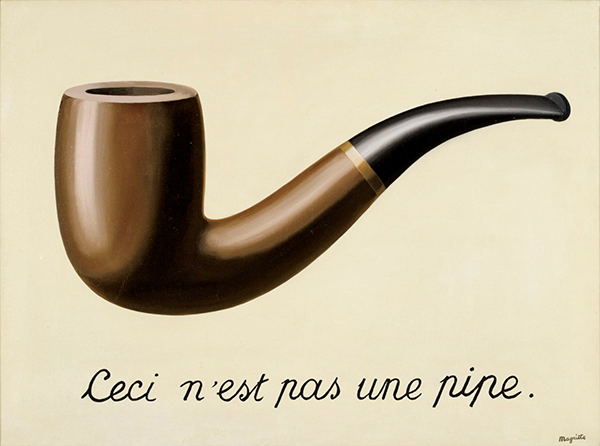
Today's virtualized world has almost reached the third order of the simulacra proposed by Baudrillard: Simulation (based on information, the model, cybernetic play, aims to total control). 7 The communication between human individuals and the assemblage has become part of the symbolism of the model. "This makes 'the subject', which emerges from the 'relentless struggle between creature and apparatus', symbolic." 8 It is becoming more and more distant from the original living being, the human being, whose individual and collective mode of functioning is deteriorating. The society undergoing this process is known as desubjectify's 'inert bodies' - thus eclipsing the politics that 'used to be predicated on the existence of a Subject and a real identity'. 9
The city, as the geographically central point of human civilization, is gradually abandoning the idea that 'humans are part of nature'. The process of urbanization is also becoming manipulated by global economic activity. We consider how proximity paradigm and eco-philosophy are a revolt against today's controlled society.
[Proximity Paradigm]
“This is a green world, with animals comparatively few and small, and all dependent on the leaves. By leaves we live. Some people have strange ideas that they live by money. They think energy is generated by the circulation of coins. Whereas the world is mainly a vast leaf colony, growing on and forming a leafy soil, not a mere mineral mass: and we live not by the jingling of our coins, but by the fullness of our harvests.” 10
The economic and ecological crisis facing humanity requires us to creatively reconcile what has become disconnected and opposed: between the different subjects in society, between humans and nature. Ecology is not only about human civilization as a whole, but also about the places where people live. The history, culture, and values of "place" are at the heart of Geddes's theory of cultural ecology, where people should be rooted in their particular area and develop respect for collective cultural values from the local community. 'Think Global; Act Local.' 11 Based on the local indigenous culture. This is what is essential for a sustainable global vision of human development. The process of design practice in terms of exploring Urbanism is a bottom-up/inside-out construction of a new ecological practice in Edi
nburgh.
The first thing that can be made clear is that Agamben believes that we have to overturn the desubjectify process formed by the present Apparatus. 'A Dissident vector is needed to activate the isolated and repressed singularity in the face of a society in which capitalism is in full penetration.' 12 This is the same concern that Guattari has for human society.
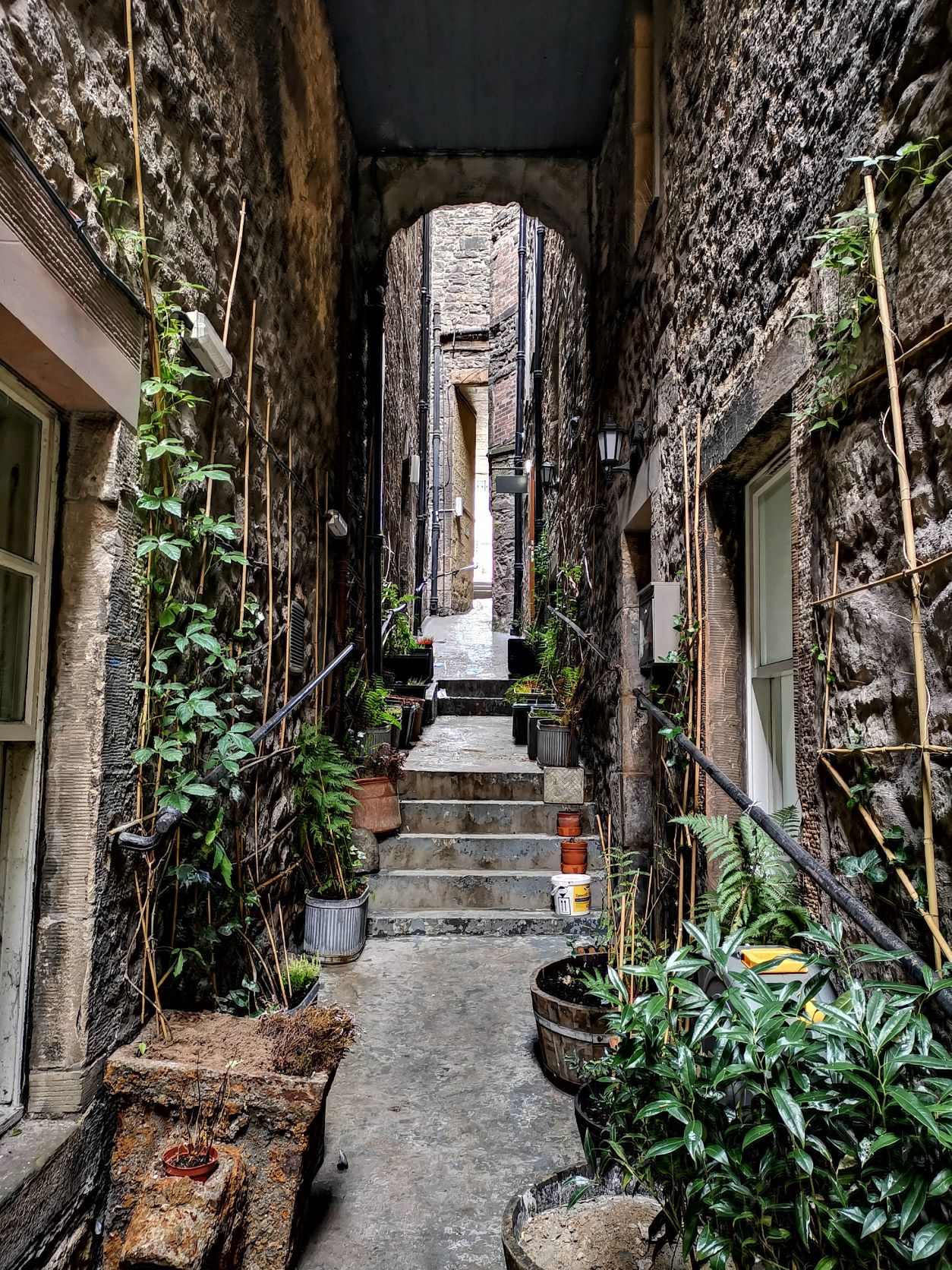
Robert Kirkwood's 'Fac Simile of Gordon of Rothiemay's Bird's-Eye View of Edinburgh' 13 confirms that in the 17th century the Old Town of Edinburgh formed a series of Closes within the city's crevices. This Gap between the high density of buildings in the city produces a complex interpenetration of spaces. The inter-subjective relationships that emerge from these narrow spaces enclosed by houses, hotels, bars, offices, schools, pavilions, etc. suggest the heterogeneity of the city within them. This proximity is also present in the human senses: the strange odors created by the many smoke vents, the sound of water flowing through the gutters, the touch of old stone walls and moss, and even the oppressiveness of dangerously dark corners.

The synthesis of human life in the community is a key element of socio-ecological sustainability. 20 years after 1880 Geddes and his wife Anna settled in James Court to improve the community of the Old Town and he initiated social experiments to encourage people from different backgrounds and professions to settle in the Old Town to create a mixed and vibrant community. 14 Today we are also beginning to think about the future of the Closes in the historical era of desubjectify and economic globalization. The proximity of different properties of space in the Closes creates a unique conflict. Proximity in the closes becomes a dissident vector formed from the local and is the beginning of subjectification and singularization in the city of Edinburgh. Then [Proximity] needs to be redefined: the spatial, temporal, and social proximity between different subjects (which can be beings or material beings of some kind) that emerges as a physical or ideological form of existence.
The Three Ecologies proposed by Guattari are from the local to the whole. The relationship between the three can be seen visually in the process of quantitative to qualitative change. This change goes to the bottom of the logic of human society, changing all areas of society by emerging from the bottom up. 'The reappropriation of value systems through a new ecology' 15. This can be considered as a form of |Ecological Urbanism|.
Similarly, the construction of a complete urban ecology practice in Edinburgh - The New Caledonian Forest - requires a series of iterative processes at different scales. Using Closes' Proximity as a point of intervention, we aim to emerge Proximity in the urban gap as Immersive Theatre - Proximity Theatre, an iterative process at different scales and temporal stages that can be understood as a process of ecosystem development and functioning, but also as resistance to desubjectification:
|Configured Urbanism| 16 begins by deconstructing and exploring heterogeneity-proximity 17 as a subject in closes, developing a series of methodologies in the initial reconfiguration of the entity of proximity.
|Performative Urbanism| 18reconceptualizes urban space as a performance space, 'where performance is redefined as the whole process of reaching and interacting with space'. 19 The first step is to build the theatre space Study in Closes on human scale (DoA). This is also the process of constructing mental ecology. These spatial subjects are interdependent, and the various parts of the theatre do not exist separately, they are in a symbiotic relationship with the closes, forming a complete and intimate ecological operating system (NoA) in this mixture. It can be understood as a kind of Intersubjectivity 20.
According to |Absolute Urbanism| 21 the theatre in the Closes is used as a point of intervention to develop from a single island into the archipelago of Edinburgh. Instead, Edinburgh is allowed to be dominated by a top-down urbanization process.'This corresponds to the relationship between different human group subjects in
social ecology.' 22
At the TLML scale, humans, the city, and nature work together to achieve an ecological balance of hybrids. Shaping Edinburgh's Proximity Atmosphere(TLML) at an urban scale - |Festival Urbanism|: These theatres constitute a new system that not only transforms the spatial experience in the Closes, but also emerges to form Edinburgh's proximity - Festival. This is also The New Caledonian Forest (NV) in Edinburgh.
If The Three Ecologies are understood as different scales, then stage (performance) - theatre - festival can be equated with mental-social-environment respectively. 'At the same time, the development of the different scales is necessarily transversal, in the sense that they intersect in their physical form, being both subordinate to each other and having separate parts.' 23 And it is not just an architectural entity, but also a system of urban functioning, a natural contract established within human society. To sum up, the Proximity Atmosphere, which is shaped by the hybrid of urbanism and Proximity Theatre in Edinburgh at different scales, can be called [Proximity Paradigm]. It is also a response to the new social and aesthetic practices desired by Guattari. Although this is the construction of a new system for the city, it is only one part of the Proximity Paradigm for the overall urban complexity of Edinburgh, which cannot even be described as a system, but rather as a process of exploring a new order in the closes.
The irony is that methodologies that aim to break the structural nature of the original system of urban processes end up trying to construct new systems to replace it. Of course, the constant iteration of the system may become a cycle: there will always be points of intervention in the city that break the existing urbanization process, and the balance between the controllable and the uncontrollable may be the new normal of urban development. It is, of course, impossible to completely deny the value of a de-subjectified society. At the same time, there is no real complete subjectivation, nor is it possible to ignore simulacra and enter the so-called real world completely.
References
- IWC is delocalized and deterritorialized to such an extent that it is impossible to locate the source of its power. Félix Guattari, The Three Ecologies, trans. Ian Pindar and Paul Sutton (London: The Athlone Press, 2000), 6.
- Giorgio Agamben, What Is an Apparatus? : And Other Essays (Stanford: Stanford University Press, 2009), 13.
- ibid., 14.
- Jean Baudrillard, Simulacra and Simulation (Ann Arbor: The University of Michigan Press, 1994), 3–4.
- LACMA, The Treachery of Images (This Is Not a Pipe) (La Trahison Des Images [Ceci N’est Pas Une Pipe]), n.d., n.d.
- Baudrillard, Simulacra and Simulation, 55.
- ibid., 84.
- Agamben, What Is an Apparatus? : And Other Essays , 14.
- ibid., 22.
- Patrick Geddes, Cities in Evolution, NEW AND REVISED EDITION (London: Williams & Norgate, 1949), 216–17.
- ibid., 397.
- Félix Guattari, The Three Ecologies, trans. Ian Pindar and Paul Sutton (London: The Athlone Press, 2000), 45.
- Robert Kirkwood, Fac Simile of Gordon of Rothiemay’s Bird’s-Eye View of Edinburgh, 1817.
- National Library of Scotland. “Patrick Geddes,” n.d. https://www.nls.uk/learning-zone/politics-and-society/patrick-geddes/.
- Félix Guattari, The Three Ecologies, trans. Ian Pindar and Paul Sutton (London: The Athlone Press, 2000), 68-69.
- Stanley Allen and G. B. Piranesi, “Piranesi’s ‘Campo Marzio’: An Experimental Design,” Assemblage 10, no. 10 (December 1989): 70, https://doi.org/10.2307/3171144.
- Félix Guattari, The Three Ecologies, trans. Ian Pindar and Paul Sutton (London: The Athlone Press, 2000), 69.
- Sophie Wolfrum and Nikolai, Performative Urbanism : Generating and Designing Urban Space (Berlin: Jovis, 2015).
- Daniela Lucchese, “Performative Urbanism | Book Review,” Urban Design Group, March 24, 2020, https://www.udg.org.uk/publications/book/performative-urbanism.
- Intersubjectivity has been used in social science to refer to agreement. There is intersubjectivity between people if they agree on a given set of meanings or share the same perception of a situation.
- Pier Vittorio Aureli, The Possibility of an Absolute Architecture (Cambridge: Mit Press, 2011).
- Félix Guattari, The Three Ecologies, trans. Ian Pindar and Paul Sutton (London: The Athlone Press, 2000), 40-42.
- Ibid., 58.
[Index System]
Similar to the archive construction process: 'builder-medium-archive', Agamben proposes: 'life-capture apparatus-content expression'. 1 And from the 'medium' in the archive is derived the apparatus.
The archive as a content carrier is part of the materialized expression of the new ecological practice. The focus on the construction of the archive's 'medium' is the same as that of the design itself: The subjectification is reconstructed in the closes and the new order is established therein.
The diversity of the archive highlighted in 'Synonyms of Drawing' 2, as well as the complex mix of subjects in the city of Edinburgh, requires an order system as a medium to build Edinburgh's proximity, as well as to build the design. proximity, but also the design project itself.
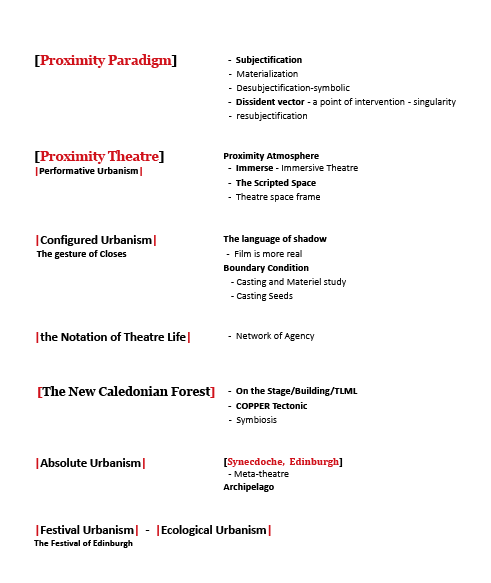
References
- Giorgio Agamben, What Is an Apparatus? : And Other Essays (Stanford: Stanford University Press, 2009), 13.
- Wiszniewski, D., Perspectival Shining, in Gasperino M., and Melis A., Shining Dark Territories, 100 Thoughts On Architecture(Pisa: Edizioni ETS, 2014) pp. 25-38.
[Proximity Paradigm] on the stage
Chapter Ⅰ
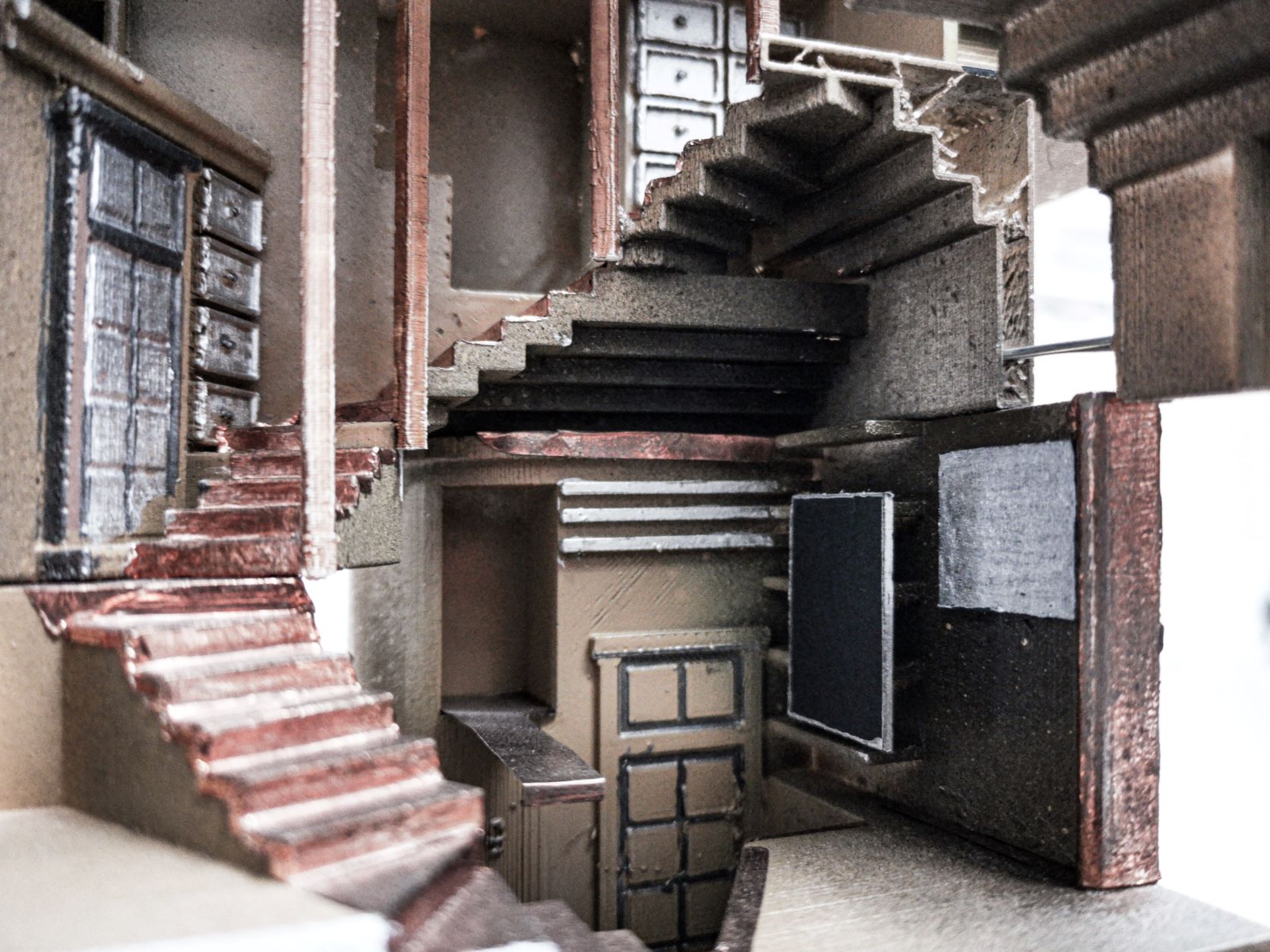
[Immerse]
Both Coccia and Geddes emphasise the importance of the leaves to the world, that the survival of humans, animals and the world as a whole depends on the atmosphere created by the leaves, that plants create the world's natural environment and that the atmosphere shapes humans and all other life. Not only plants, but all living things create the atmosphere and live in the atmosphere created by other beings. 'So this mixture of subjects is completely immersed in the atmosphere.' 1 This interrelationship of being, in which one subject or organism helps to determine another creature or subject, the world becomes of a fluid nature.
Immerse can be reinterpreted as creating the atmosphere, living in it (depending on it for survival), and generating more life through it. To be in the world necessarily means to make world:" every activity of living beings is an act of design upon the living flesh of the world." 2 This symbiosis of subjects creates an atmosphere that also means that "Everything is in Everything." 3 In other words, the construction of an urban environment in which the subject mixture is immersed in the atmosphere is the basis for the formation of a new life by proximity.
Immersive theatre is a unique form of theatre that immerses the audience in the performance itself by removing the stage. Instead of being confined to a specific space, the performance allows the audience to talk to the actors and interact with the surroundings, thus breaking the fourth wall. The theater is conveying the experience of storytelling in the physical sense of three dimensions, where he expresses the physical and spiritual worlds together in the performance space. This is in contrast to the simulacra expressed only by images, sounds, and words, where people can immerse themselves in the atmosphere formed by the performance through real senses of touch, taste, and smell. The human being can truly penetrate the proximity of the environment.
Even performance spaces can break through the so-called architectural constraints of space; |Performative Urbanism| shifts the perspective from the city as a whole to the street. Performance no longer appears only on the stage. 'By simply walking or strolling down the street, a person becomes part of a theatrical or other event. This shift makes us interested not just in iconic buildings, but in a quality public space'. 4
[Proximity Theatre]
Of course, proximity itself has always been in the urban space and in the history of the city, and Closes itself is a unique public space in the city in which one can naturally feel the performance of the city. When one enters the Closes, one has already entered the Proximity Atmosphere(BODY) 5 - a kind of natural Immersive Theatre.This is why Proximity Theatre, with its theme of proximity and the narrow streets of the Closes as the performance space, becomes a singular point of interpenetration between subjects and breaks the existing fragmented relationship between subjects in the city.
At the same time, the theatre's dramaturgical expression of culture, history, and life in the closes is a way of fostering respect for Edinburgh's old town - the 'place'. This is the growth phase of 'Think Global; Act Local.' 6 of being immersed in the local cultural ecology. The city in this argument is not just a simple space dominated by the IWC. The urban performance space has a degree of unpredictability, complexity, and ambivalence in the way people perceive and use space, and is capable of transformation and adaptation. The process of performance can be redefined in this view: 'it is not just a one-way output in the traditional sense but is about the process of people getting there and using it.' 7 This is where personal perception, subjective tendencies, and spatial guidance play a key role.
The Scripted Space(方法论)
Like the theater director who sets the stage, the content of the script is expressed through the narrative of the performance. proximity in Close becomes the "script" that guides the design of the theater, and I call the methodology of its expression and materialization into space
- The Scripted Space 8. Through this design method, the scenes, installations, flow, and materials of the theater will make the space very "complex" and full of narrative. The process of building this complex theater space is the process of subjectifying proximity on the Body Scale. This allows people to immerse themselves in Proximity as they pass by windows, walls, steps, corners, and streets.
The inter-subjective relationship between theatre and nature is also sought in the history of closes and the natural philosophy of plants, and is iteratively shaped by the materials and interactive installations in COPPER Tectonic 9 shaping the scenes.
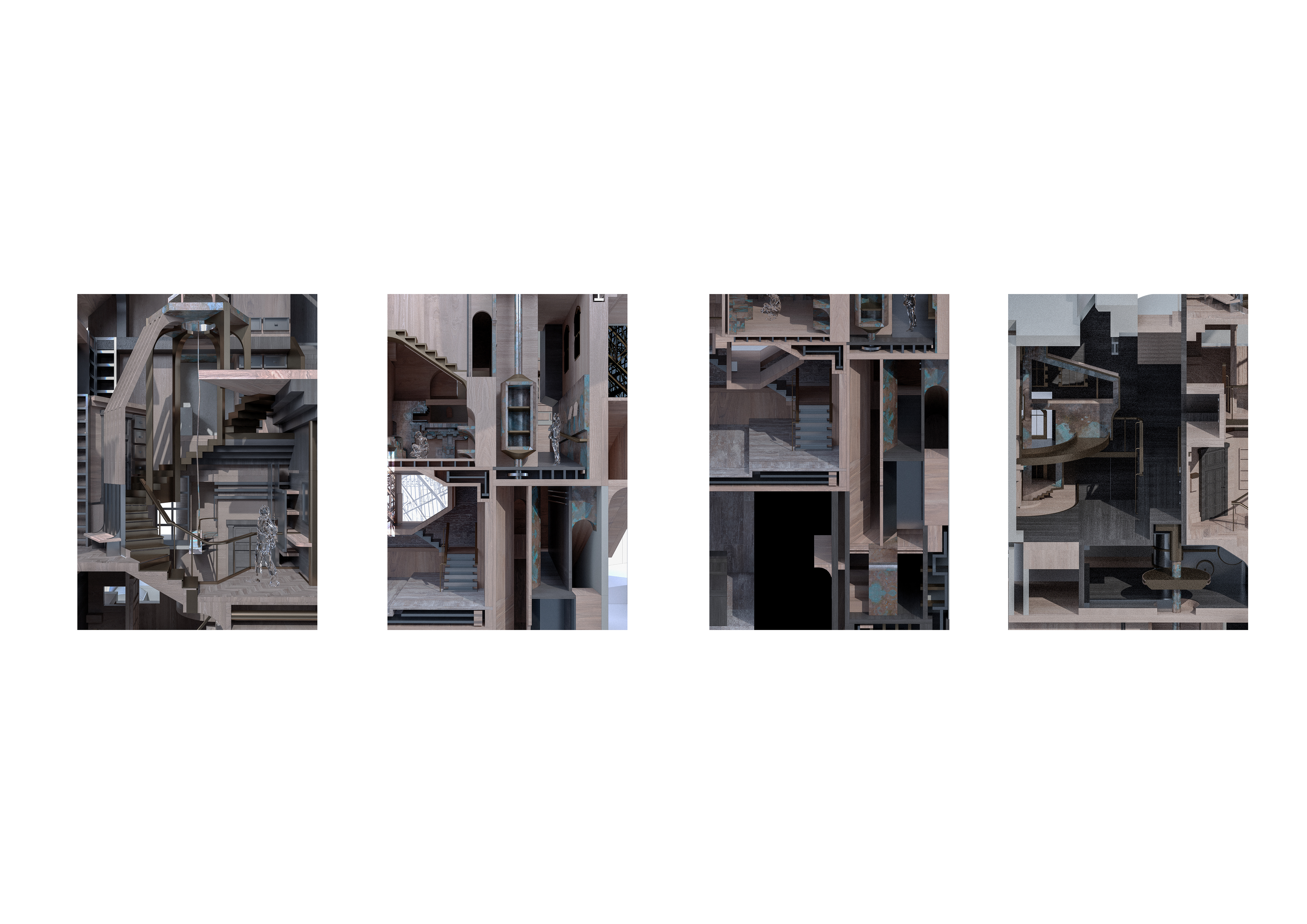
[The New Caledonian Forest] on the stage
“The world has the consistency of an atmosphere and the leaves are witness to this fact. I will ask the roots to explain the nature of the Earth. Finally, it is the flower that will teach us what rationality is… measured as a cosmic force.” 10
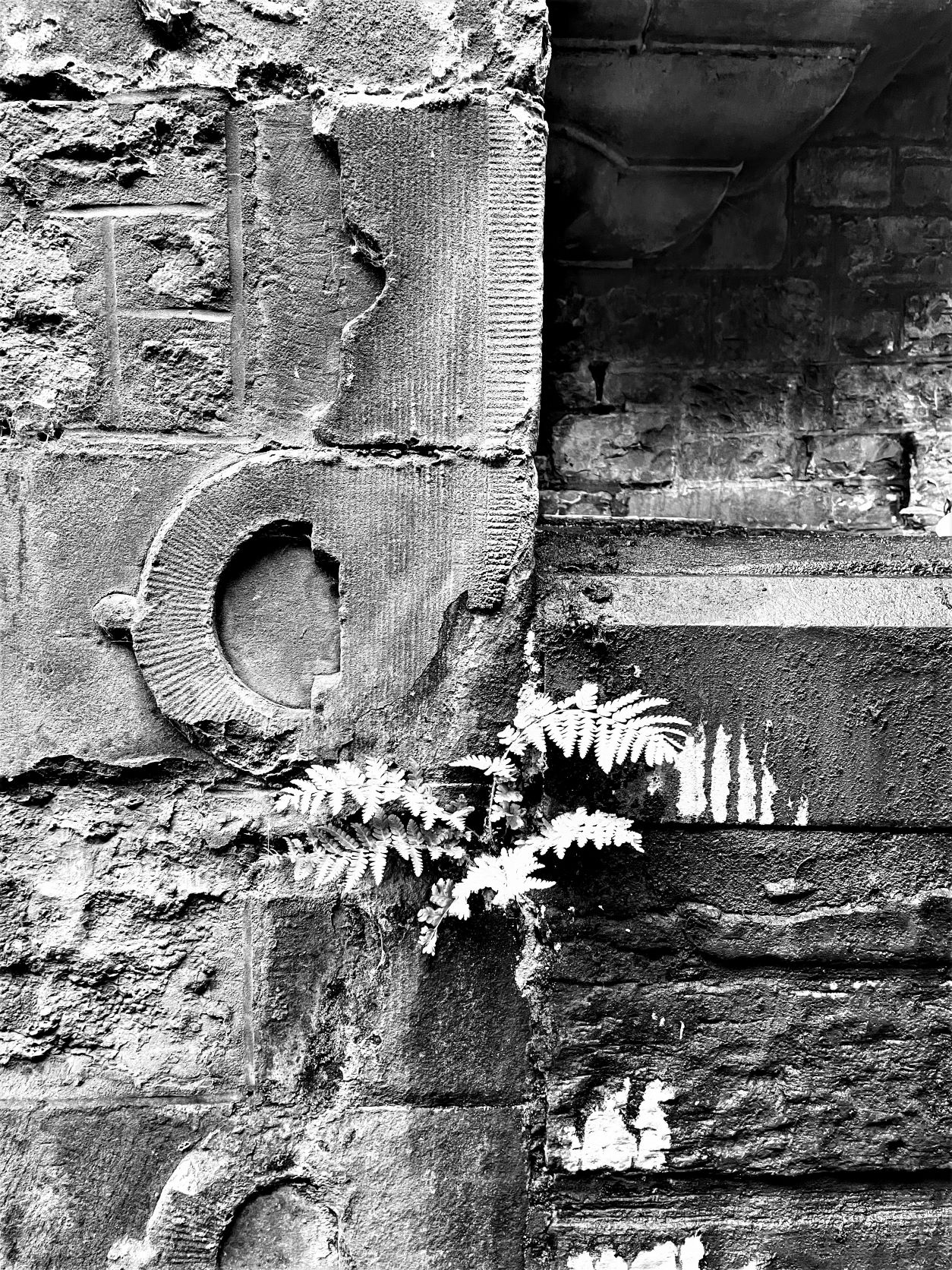
The forest is a metaphor for a renewed emphasis on the need for human society to think anew about the forms of existence of natural philosophy. 'Humans should stop recognizing themselves as subjects who consume nature'. 11 In detail, the forest is forever immersed in each other, interpenetrating, in a symbiotic relationship both in terms of spatial form and in terms of life connection. This is the basis for the order that emerges to form the forest on a larger scale. While humans and human creations have always fed, permeated, and shaped life on earth in the same way as plant ecology. Humans should be aware of the impact of urbanization and the social activities within it on themselves and other subjects. The process by which we construct the relationship between urban subjects from the ecological philosophy of plants is the process by which The New Caledonian Forest grows in the soil of closes.
[COPPER Tectonic]
At the BODY scale, The Leaves in the forest metaphorically represent, a symbiotic relationship between different subjects. Humans, theatres, and other urban spaces act as a mixture of subjects, immersed in the atmosphere that these subjects form together. The subjects are shaped and permeated by each other through a certain organ. The flower in the forest is considered a symbol of rationality because it is a "site of a sexual exchange with other creatures" 12, coccia refers to the 'sessile' flower as being a "site of an environment for the world itself." 13 The "flower" can be said to be the organ of attraction, interaction, absorption and development of different subjects.
In Proximity Theatre, the flower is redefined as. devices that interact with the audience: handles, switches, handrails, walls, and all the places where different subjects interact and permeate each other.
Gilles Clément defines the area of interpenetration between humans and nature in urban space as the 'Third Landscape'. 14 In other words, it is a heterogeneous, border space between human and natural subjects. This view is consistent with the place metaphorically represented by the flowers in the theatre, 'as a field of diversity and resilience created by the third landscape that should be seen as the public space of the future'. 15 That is, the theatre space itself is a public space of diversity and resilience formed between subjects.
The growth of the natural philosophy in the forest in Close implies a process of materialisation. COPPER is redefined as a metaphor for carrying nature and time (the history of the Close). The patina of the copper itself is a trace of wetness, atmosphere and time in the Close, a penetration of nature into human production (the Close). It is also a metaphor for the mutual symbiosis between subjects. This particular form can be defined in terms of the [COPPER Tectonic]: a specific theatre installation, scene, structure, shaped by the interpenetration of different subjects, governed by "reason". And it also corresponds to different metaphors on different scales.
References
- Emanuele Coccia and Dylan J Montanari, The Life of Plants : A Metaphysics of Mixture (Cambridge, Uk ; Medford, Ma: Polity Press, 2019), 32–40.
- ibid., 40-50.
- ibid., 59.
- Daniela Lucchese, “Performative Urbanism | Book Review,” Urban Design Group, March 24, 2020, https://www.udg.org.uk/publications/book/performative-urbanism.
- The environment shaped by the urban subject based on proximity formation exists in different Atmospheres at different scales, which are nested with each other.
- Patrick Geddes, Cities in Evolution, NEW AND REVISED EDITION (London: Williams & Norgate, 1949), 397.
- Daniela Lucchese, “Performative Urbanism | Book Review,” Urban Design Group, March 24, 2020, https://www.udg.org.
- Methodology for the construction of spatial details in the theater, a metaphor for the philosophy of nature.
- It can be understood as a narrative architectural spatial expression that leads through each scene choreography to form the details of each part of the space (DOA).
- Emanuele Coccia and Dylan J Montanari, The Life of Plants : A Metaphysics of Mixture (Cambridge, Uk ; Medford, Ma: Polity Press, 2019), 27.
- Theodor Adorno, Aesthetic Theory, trans. Robert Hullot Kentor (Minnesota: University of Minnesota Press, 1998), 69.
- Emanuele Coccia and Dylan J Montanari, The Life of Plants : A Metaphysics of Mixture (Cambridge, Uk ; Medford, Ma: Polity Press, 2019), 80-82.
- Ibid.
- Gilles Clément, Manifeste Du Tiers Paysage (Paris: Sujet - Objet, 2004), 1–20.
- Ibid.
The [Proximity Gesture] of Closes
Chapter Ⅱ
[Configured Urbanism]
Faced then with the problems of the present age, Agamben suggests that 'Apparatus is first and foremost the machine that produces subjectify, it is also the machine that governs.' 1 He also hints at its principles: '1. guidance, constraint, and command beings 2. natural existence itself consisting of purely material entities.' 2 This is also a necessary condition for subjectify.
In the concept of Configured Urbanism, it is meaningless to describe the form of a city or building to build or design it. Specifically, Piranesi focuses on the value of origin and the exploration of the city's ruins, reconstructing the ruins of Rome and presenting his designs as astonishing, almost utopian reinventions. This process is a reconfiguration of the ancient Roman city, and his drawings and techniques can also be interpreted as a process of constraining and reconfiguring the architect's guidance of the city's ruins through apparatus ('Etchin') 3. At the same time, it is essentially understood as a 'medium' similar to Freud's Mystic Writing Pad.It is also the process of constructing gesture.
The [Proximity Gesture] of closes
'It is first of all a forceful presence in language itself, one that is older and more originary than conceptual expression.' 4
As Closes, a narrow spatial form in the city and its peculiarities, and also because of its urban evolution through the centuries, can necessarily be understood in space and time as many different kinds of Gesture. 'Gesture encompasses the movement of the subject itself, as well as the reading of the movement of the body.' 5 Gesture is not only the form of the building, but the movement in space and time, and the intention or meaning it conveys. For example, the Closes are described as shadowy, high-density streets, a gesture of staggered, complex, multi-layered roofs, and the 'Fishbone' of the striped urban map base relationship, a Gesture that undertakes the movement of the population between the topographical differences between north and south.
In other words, this is not just the gesture of a single close, but should be understood as the Gesture of over 70 Closes in the Old Town: the Gesture that expresses Edinburgh's proximity (the Gesture of the city).
The Language of shadow
For the configuration of the city-specific methodologies need to be investigated, specifically the discovery of particular boundary conditions in light, shadow, and film as a means of constructing configurations for the materialization of proximity.
“We find beauty not in the thing itself but in the patterns of shadows, the light and the darkness, that one thing against another creates.” 6
The unique gesture of the glass windows on the façades of the churches and new colleges in the Old Town, which carry the sunlight through the glass, creates an image of another world. The sanctity of the churches and the splendor of religious legends are projected into the human eye through these huge windows. Light and shadow are also a medium through which light can be reconstructed and a language formed by being filtered through glass and obscured by solids.
Film is more real
Inspired by glass window flowers, we laser engraved the texture drawings of the closes onto transparent acrylic, overlapping them in multiple layers to form a model, using light and shadow to construct the proximity gesture. In contrast to models and photographs, the film can record the performance of light and shadow in time and space, just as vampires are shaped in Nosferatu 7.
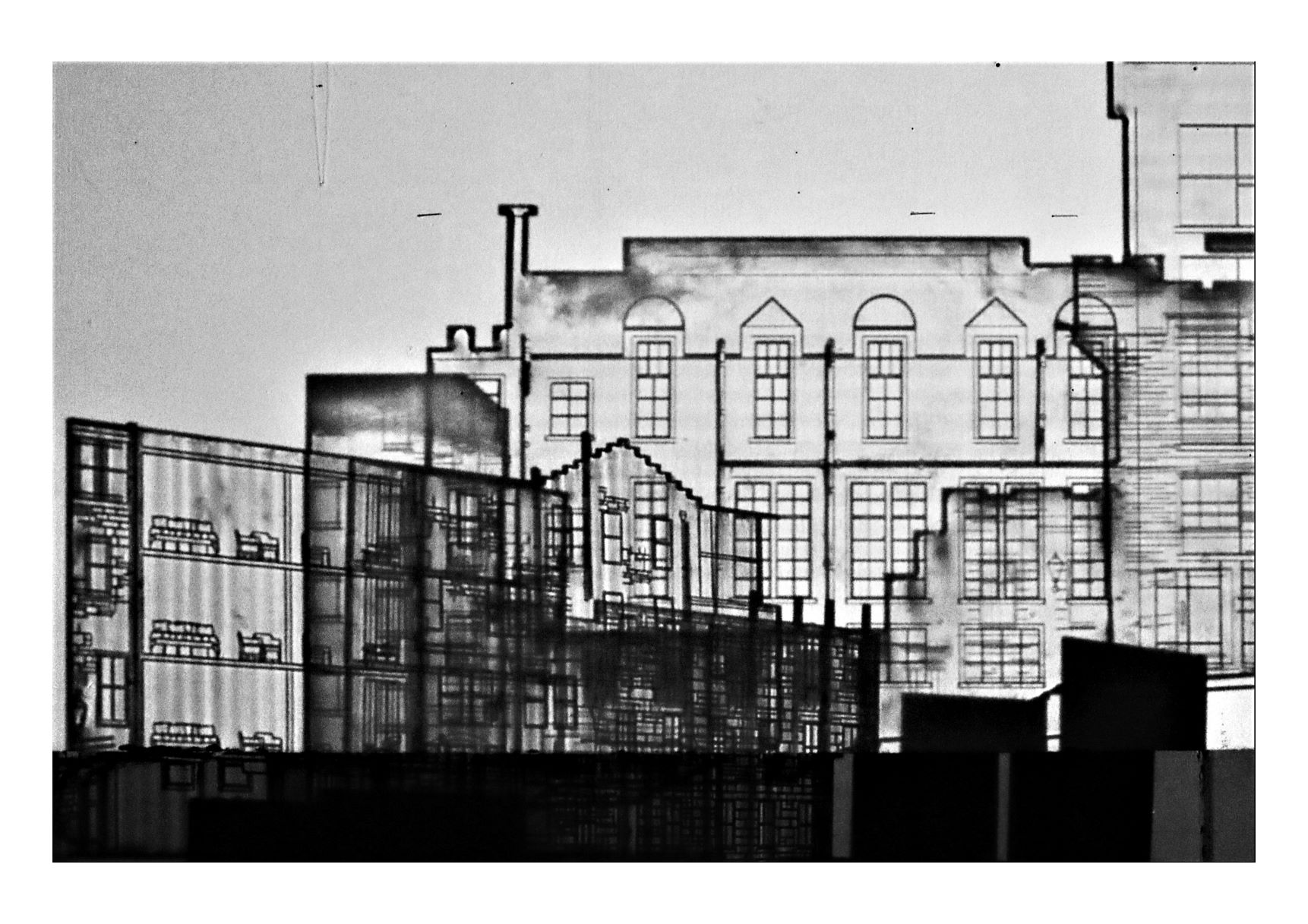
Light, model, and shadow become the apparatus for the construction of the image, as well as the characters and the scene (street) in the film. In other words, the process is like standing behind a glass window and thinking about the meaning of a church.
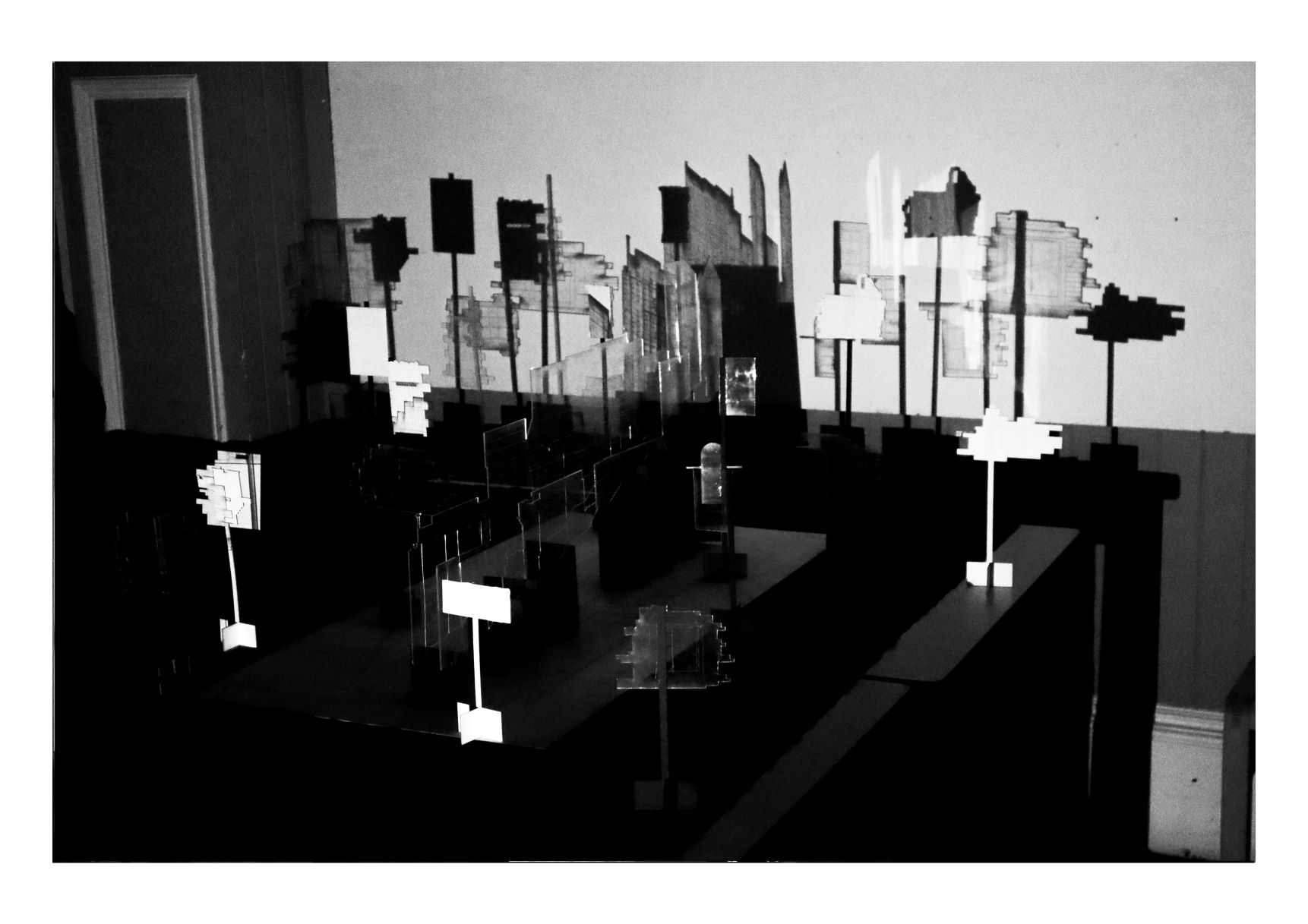
[Boundry Condition]
The boundary condition is diverse and complex, and the focus here is on the boundaries formed by the interpenetration of subjects in the Proximity Atmosphere. This permeation is between the different elements in the close, and between human production and nature in the allotment.
Gilles Clément defines a particular human-nature boundary, defining the "Third Landscape" as "designates the sum of the space left over by man to landscape evolution – to nature alone " 8 In other words, these neglected spaces appear on the edge of the city or also on the border between two territorial types: urban-rural, rural-industrial, etc. It is a heterogeneous, border space between human and natural subjects. In contrast to territories controlled and developed by humans, the third landscape forms a privileged area for the reception of biodiversity. This privileged area can be interpreted as a boundary shaped by the proximity of the city to nature.
Coccia emphasizes that "Rationality is a matter of forms, but the form is always the result of the movement of a mixture that produces variation, change." 9 The place formed by the inter-subjective interaction represented by the 'flower' is similar to the spatial properties of the boundaries of the third landscape, but the rationality represented by the 'flower' is the opposite of the territory neglected by humans. In other words, the third landscape can be understood as a sensual space belonging to different subjects at the same time, The diverse field created by 'out of control'.
The theories of Gilles and Coccia made me rethink the presence of Allotment in Edinburgh, which seems to be a kind of 'captive' nature in Edinburgh. Similar to the third landscape, this can be understood as the interface between the human city and nature. But allotment is the opposite of the Third Landscape; it is not a space left by humans for the evolution of the landscape, but a new occupation of nature by humans. In other words, this is the landscape that nature has left to man.
On a larger or smaller scale, an 'infinite' boundary can emerge between subjects. for the city, the whole allotment is the boundary. the same closes can be understood as the boundary of proximity in the old city. and the future-oriented The NV is also the boundary where the Caledonia forest grows in the city.
At smaller scales, the boundary itself can also form a boundary within it. In proximity gesture, the interlocking, overlapping boundaries formed by Closes' diverse and complex urban spaces are recorded in the film. We began to explore ways of advancing the materialization of proximity through the development of boundary conditions. Specifically, through the representation and evolution of the relationship at the bottom of the diagram, different boundaries are presented in the plane of allotment and the shadow of close.
[Boundry Condition] - "Casting Seeds"
借助coccia的Leaf Theory 10,closes中主体混合体形成proximity atmosphere的同时就在创造新生命。实体化的第二阶段开始在closes空间涌现形成生命的种子:
Proximity gesture(film)中的boundary不仅是在二维中的图底关系。这可以被重新投射在三维的被重新配置的closes(model)中,形成构建proximity剧院实体的种子。
构建“Casting Seeds”的方法
· 材质研究:film记录了不同的重叠方式形成的影子的不同质感。并且我们把不同的质感映射为透光度和颜色不同的材质。(石膏 蜡 果冻 树脂)。
· 注模:通过注模的方式制作物质实体。再将其重新安装到configured的closes的模型中,回到光线和影子的环境里。
References
- Giorgio Agamben, What Is an Apparatus? : And Other Essays (Stanford: Stanford University Press, 2009), 11.
- ibid.,6-23.
- Sergei M. Eisenstein, Piranesi, or the Fluidity of Forms, trans. Roberta Reeder, 1977, 85.
- Giorgio Agamben, Potentialities : Collected Essays in Philosophy, ed. Daniel Heller-Roazen (Stanford, Calif.: Stanford University Press, 1999), 77.
- Vilém Flusser, Gesture (Minneapolis: University of Minnesota Press, 2014), 3.
- Jun’ichiro Tanizaki, In Praise of Shadows. (S.L.: Vintage Classics, 2019), 29–30.
- Murnau, F. W. “Nosferatu.” Film. Prana Film, May 4, 1922.
-
- Gilles Clément, Manifeste Du Tiers Paysage (Paris: Sujet - Objet, 2004), 1–10.
- Emanuele Coccia and Dylan J Montanari, The Life of Plants : A Metaphysics of Mixture (Cambridge, Uk ; Medford, Ma: Polity Press, 2019), 87.
- Emanuele Coccia and Dylan J Montanari, The Life of Plants : A Metaphysics of Mixture (Cambridge, Uk ; Medford, Ma: Polity Press, 2019), 27-59.
The Notation of [Theatre Life]
Chapter Ⅲ
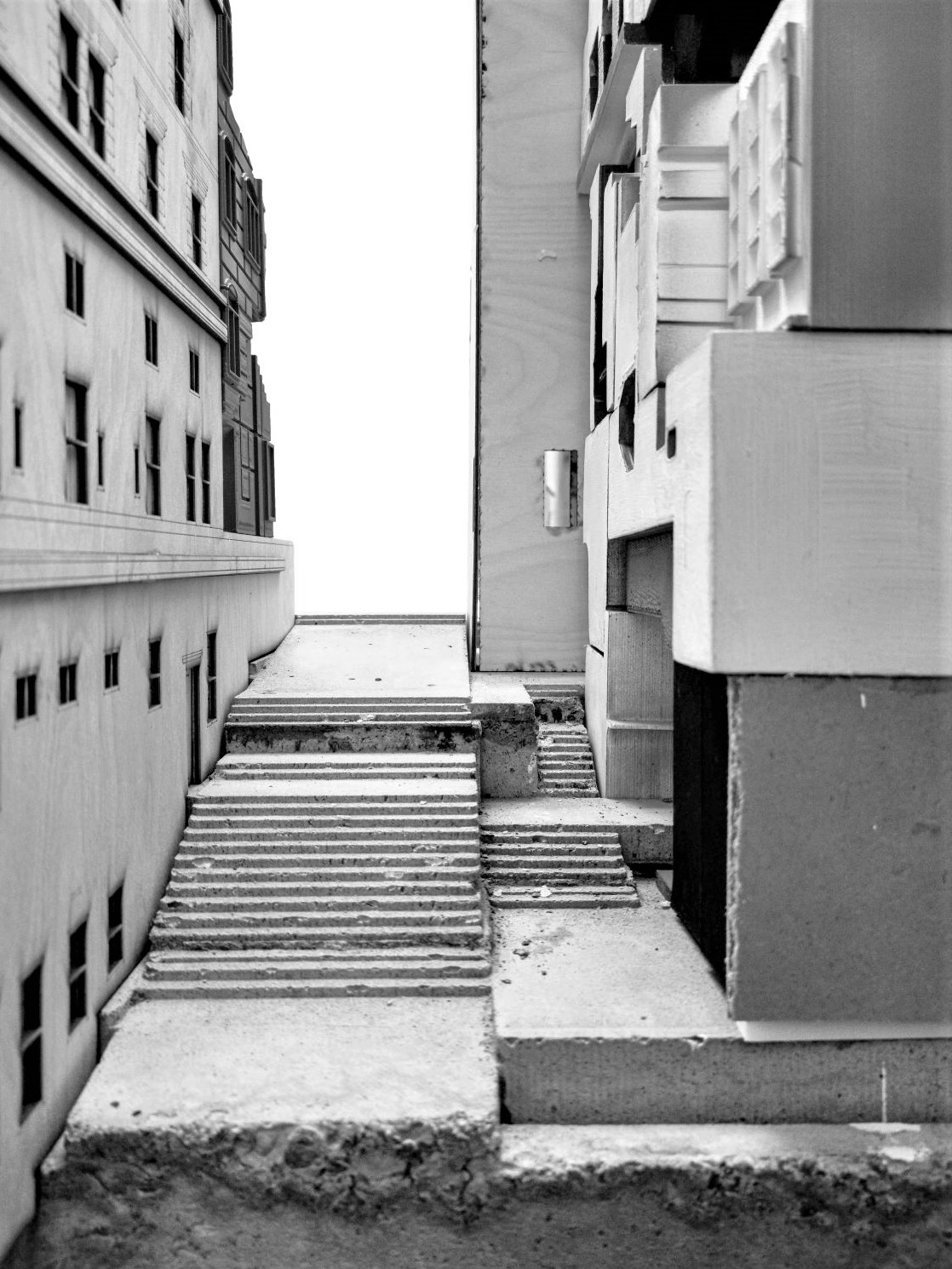
[Ecological Urbanism] - Network of Agency
Gregory Bateson的论点与达尔文的自然选择理论相反:"The unit of survival is organism plus environment." 1这可以精简的解释“subject”与“个体”的不同。自然中的各种主体无法脱离彼此维系生命,物种多样性构成的 混合体形成的 Atmosphere,是生存和新生命诞生的基础。
"Our greatest need today is to see life as whole, to see its many sides in their proper relations; but we must have a practical as well as a philosophical interest in such an integrated view of life." 2
geddes认为“life”是一个相互依存的“生态整体”。他著名的 'Notation of Life' 3表达在一个健康的社会中,生活的每个部分都相互连接。在Closes中构建the notation of theatre life,是形成 **proximity的生态新秩序- PARA-Situation [Edinburgh]**的关键。探索人们在其中的基于当地文化的生活方式是构建可持续的人类社会的基础。对于爱丁堡来说,Closes中的proximity theatre的生活整体是城市生态实践的第一个探索— The [FABB] Agencies。所以theatre life不仅仅发生在舞台上,剧院的运作连接了多种空间:
Work:box office、空间引导、表演编排、道具服装制作和存贮,甚至是负责剧院设计搭建的工作室。
Life:咖啡,酒吧,厕所,公寓。
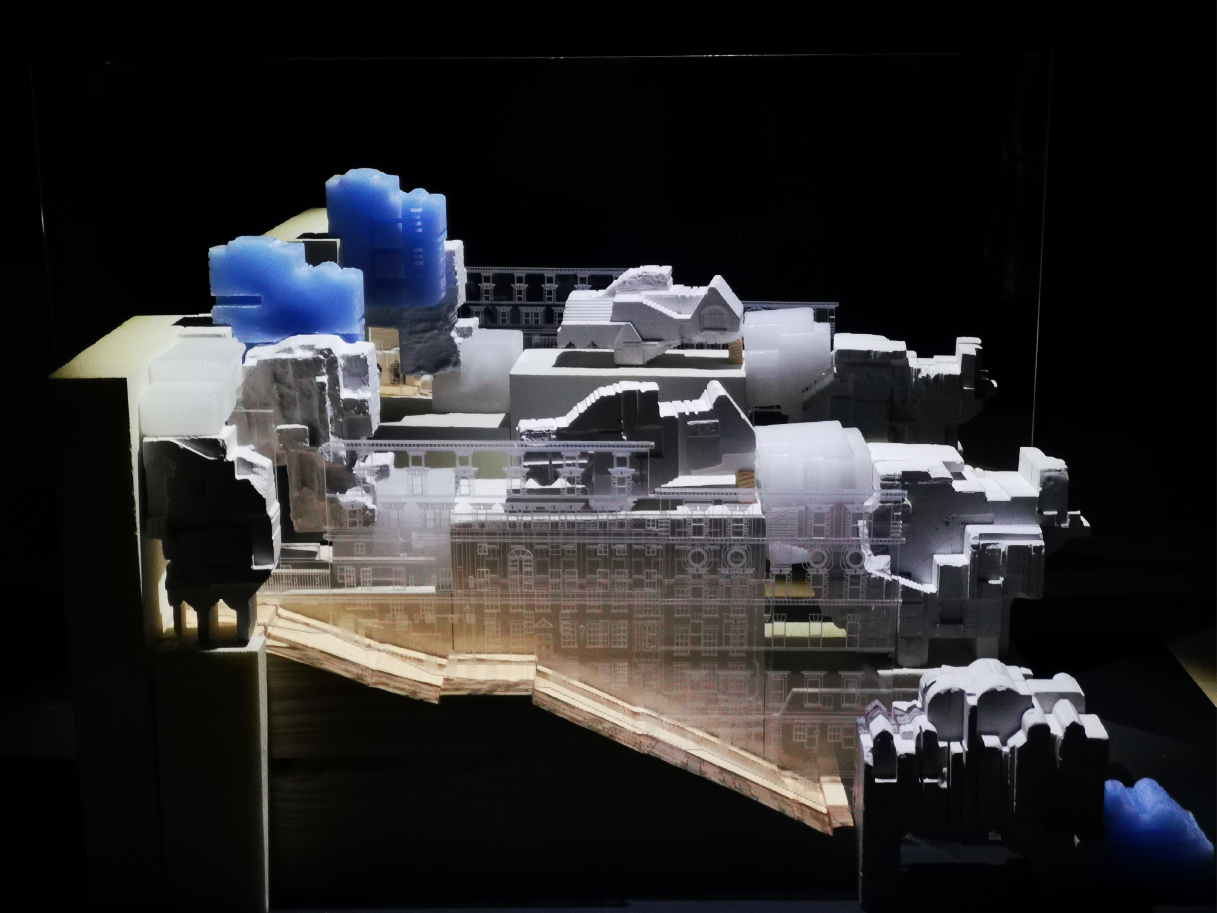
这些剧院生活必然需要空间实体的承载。 Proximity Gesture形成的boundary实体也在这个过程中被赋予生态,文化,生命。这些分离的Casting Seeds不再是单独存在的干预点,而是被生活统一为相互依存的“接近性生态整体”。和自然生态系统一样,构建完整的New system是proximity在更大尺度上由内而外的可持续的涌现新生命的基础。
The Notation of [Theatre Life]
可以说接近性并不仅限于空间上的渗透,剧院对于closes来说主体间关系的重新构建也是对proximity重新搭建。如同自然中主体间network也并不只是通过物理上的联系来进行。coccia让我重新开始理解'Flower' 4的意义,蜜蜂可以将植物的花粉传播到几英里远的地方,这是生命的基础。

这足够让我们开始重视生活上的接近性-network的构建。蜜蜂和花朵可以是生活中的人类和剧院,这也是形成系统运作的必要条件。Closes中的life所形成的系统必然强化或者重新构建了主体之间的共生network。这种共生关系使得城市空间不再被明确的划分。 具体的来说是通过Casting Seeds所形成的建筑语言,在close中建立一系列剧院生活空间。
Performative Urbanism 5 - Closes
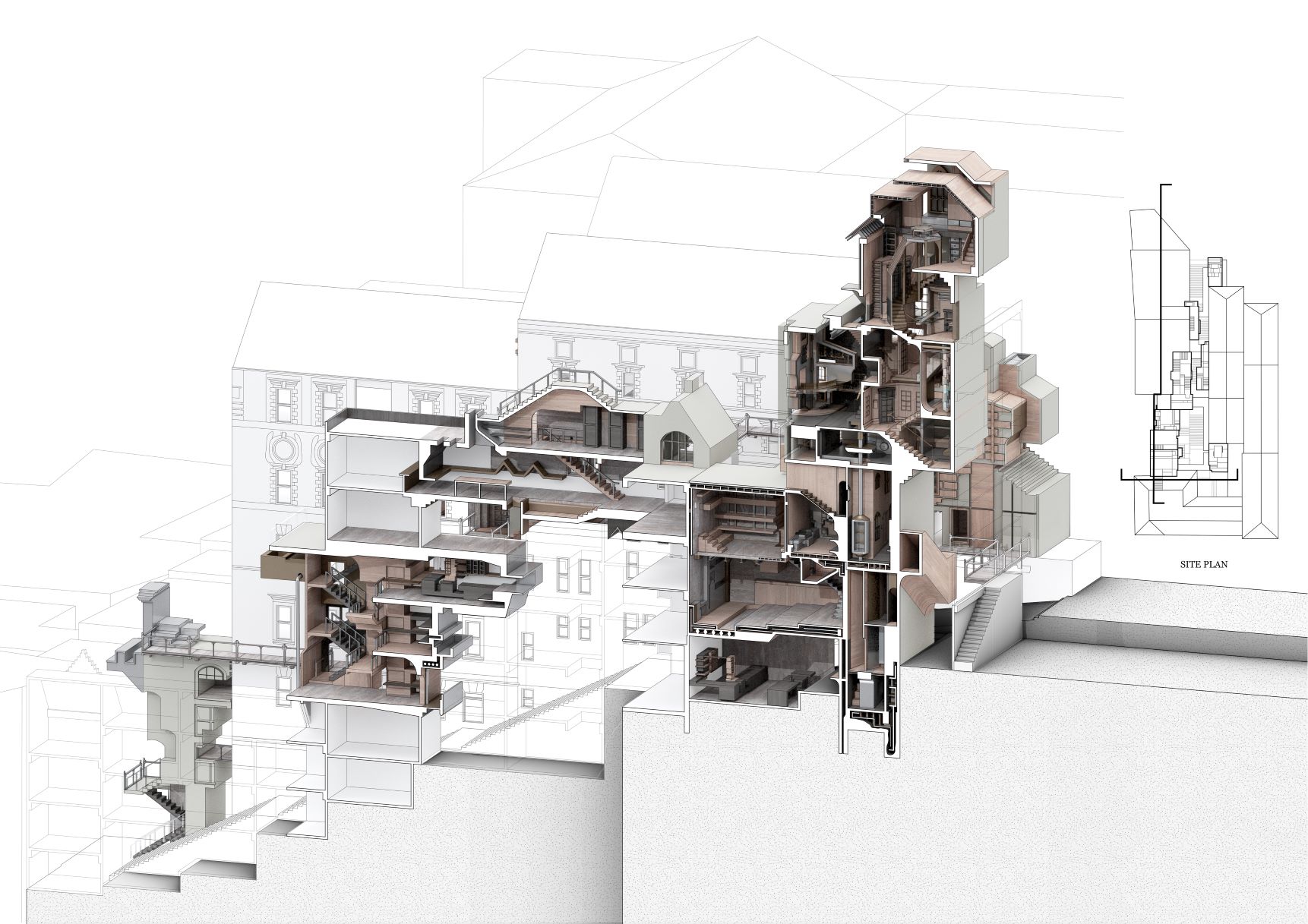
沉浸式剧院在其中并不只是构建新的类似传统剧院的标志性空间,作为新主体对于环境的塑造,使得Closes也成为表演的一部分。城市公共空间和剧院空间的界限模糊化 6。Closes中的各种类型的主体,都成为表演空间的一部分,也都沉浸在他们共同塑造的 **“proximity的atmosphere”**中。这些主体间的交互所形成的秩序,形成了closes中的完整亲密的生态学运行体系(NoA).
References
- Gregory Bateson, Steps to and Ecology of Mind (New York, 1972), 491.
- Philip Mairet, Pioneer of Sociology : The Life and Letters of Patrick Geddes (Westport, Ct.: Hyperion Press, 1979), 1–22.
- Geddes, Patrick. The Notation of Life. 1927.
- Emanuele Coccia and Dylan J Montanari, The Life of Plants : A Metaphysics of Mixture (Cambridge, Uk ; Medford, Ma: Polity Press, 2019), 99–105.
- Sophie Wolfrum and Nikolai, Performative Urbanism : Generating and Designing Urban Space (Berlin: Jovis, 2015).
- ibid.
[Synecdoche, Edinburgh]
Chapter Ⅳ
[Proximity Theatre] in Studio
“There are nearly thirteen million people in the world. None of those people is an extra. They're all the leads of their own stories. They have to be given their due.” 1 ― Charlie Kaufman

在Charlie Kaufman’s *“Synecdoche, New York”*中Philip在一个不真实的世界中寻找真实的自我。但是他又忙于创造一个世界而忘记了生活在另一个世界中。影片中他导演了一部戏剧,他在剧中扮演了他自己,把自己一生提喻成了人生中的人生。纽约也在戏剧中被提喻成一个由厂房构成的剧场,成为了城市中的城市。
.jpg)
Proximity Theatre是在爱丁堡中被提喻的 Meta-theatre,剧院演绎的是Closes中proximity Life,这是对城市生活的提喻,在Closes中感受演绎Closes的戏剧。这种提喻并不是只是在空间上的,在时间(历史)上也是如此。
我们生活在爱丁堡中,在Studio中搭建爱丁堡的城市发展和未来。这种由内而外的设计过程,使得Studio成为了对爱丁堡城市的提喻(城市中的城市)。而theatre模型本身就是对于城市的隐喻。有趣的是,这就成为了“城市中的城市中的城市”的嵌套关系。所以studio中的剧院模型是对于爱丁堡的提喻。 而archive本身甚至可以被理解为再一次的提喻。
这种Meta-theatre的嵌套关系涌现了很多思考,Close Studio作为设计者,是 Synecdoche Edinburgh的导演(同Philip一样)。并且我们是在寻找“城市的自我”(但不是个体的自我)-Proximity。我们都融入在爱丁堡的生活中,又是城市中的“演员”。
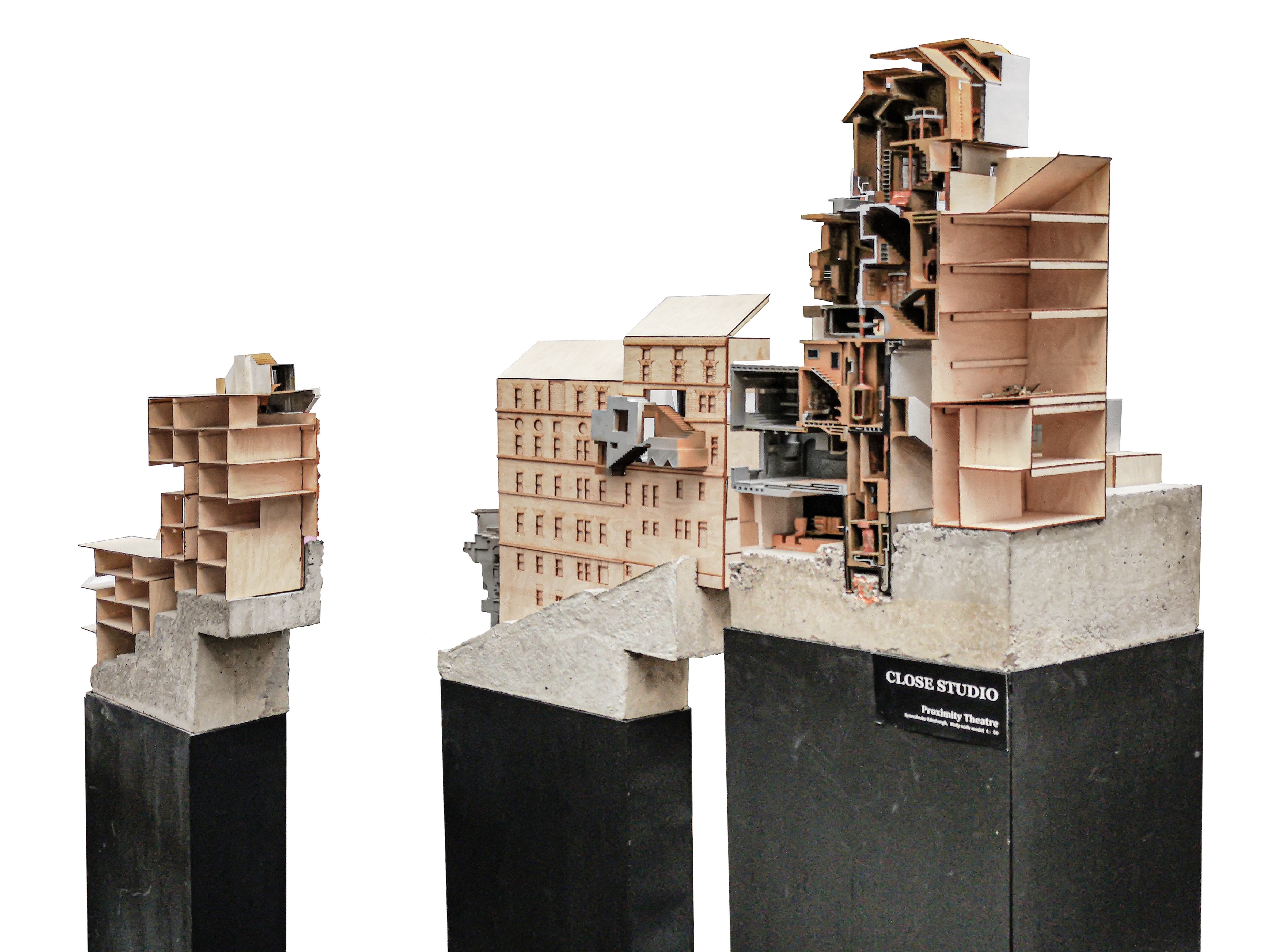
[Absolute Urbanism]
如何从分离的主体发展为基于生态学价值体系的城市环境。 Absolute Urbanism的论点是:建筑必须从城市空间中分离。建筑形式与它所构思和建造的城市环境作为一个对立面,尽可能的强调建筑形式的个性。 2(但这并不是彻底的分离,因为有了“其他”的部分,绝对建筑才得以存在。)这与Guattari提出的heterogenrity和孤立和压抑的奇点的理论非常契合。这两者对城市设计的项目都没有采取总体规划的形式,而是表示为特定地点干预的 “Archipelago”,并且与系统性和结构性相对立。所以可以说绝对建筑也是在建筑学意义上新生态学体系建立的基础。
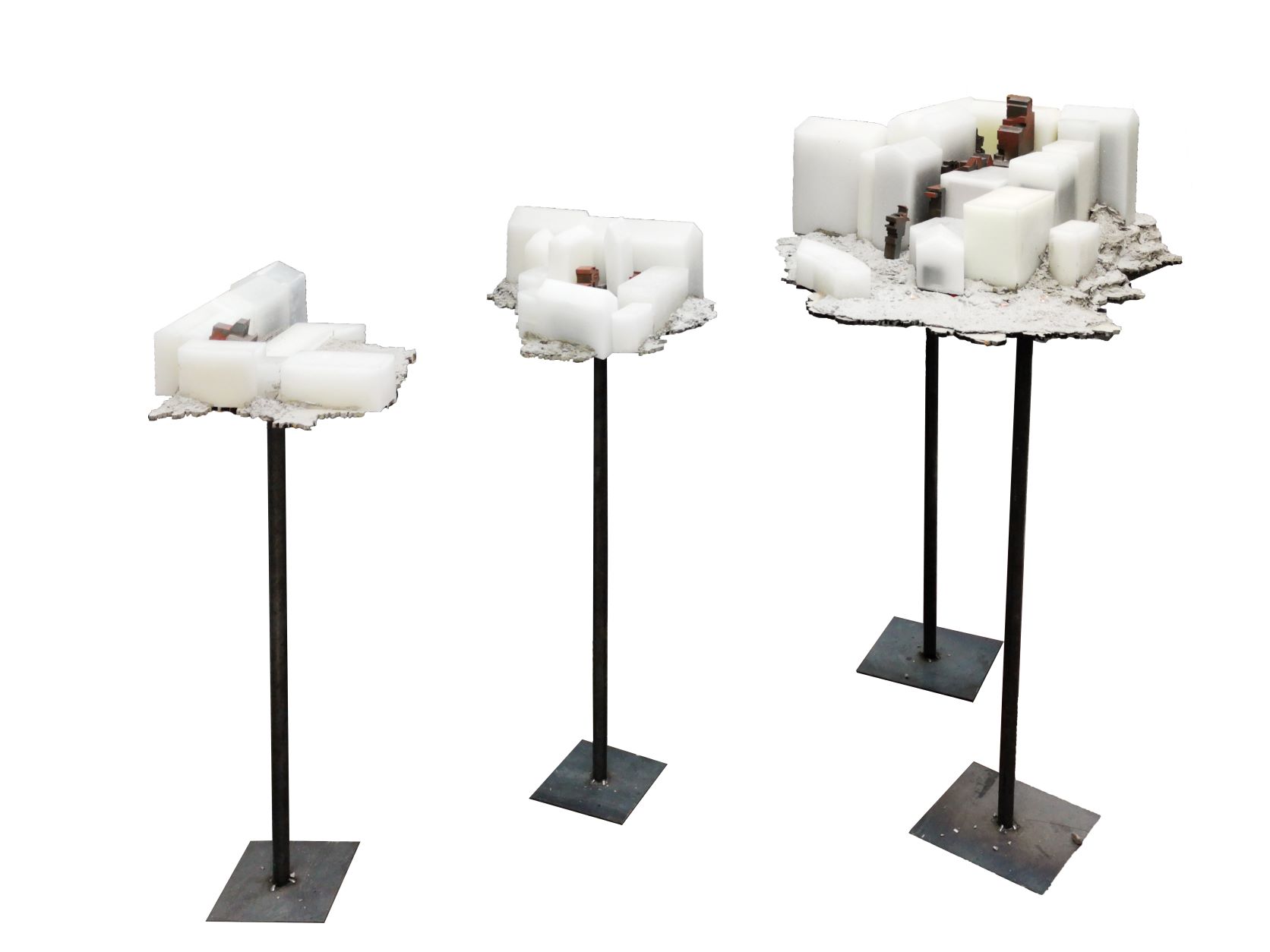
Closes中的theatre作为干预点,从单个岛屿发展为爱丁堡的 Edinburgh's Archipelago。基于proximity gesture方法论,形成在多条closes中的多个干预点。Close空间中的Proximity Atmosphere创造形成 “new life”(COPPER)。在royal mile的错综复杂closes中,多个不同的干预点开始向更大尺度渗透。(Casting Seeds in Closes)在SET Scale上,植物已经从叶子,根,花朵,枝干,成为了一定数量规模的混合体,或者可以称之为 Grove ,before forest。迭代之后的剧院又对closes城市空间进行渗透。生命诞生的同时就开始影响atmosphere和周围主体。(剧院开始渗透closes,Theatre in SET)
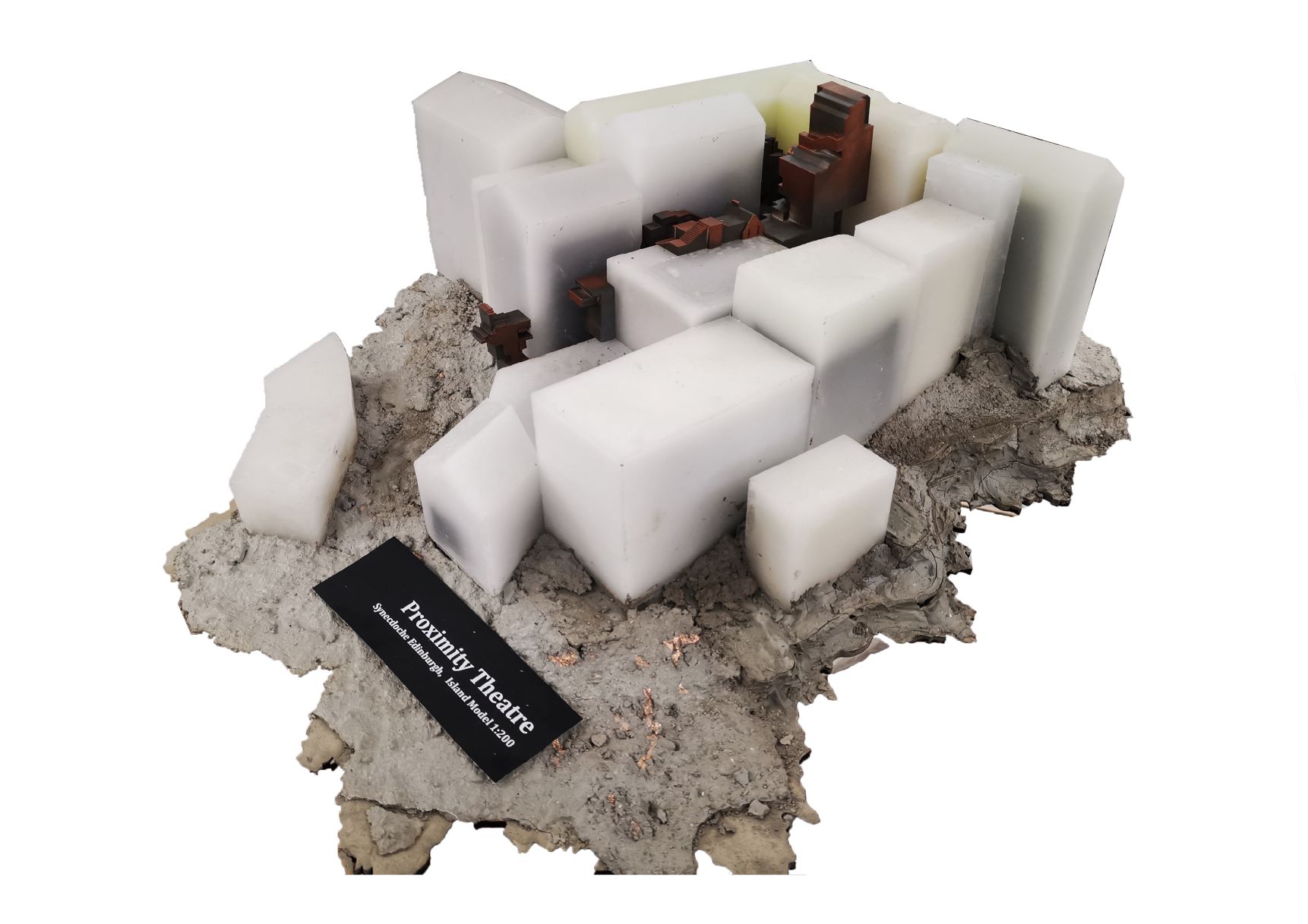
借助Closes的模型和材质的 'iteration' 3,我们在亚克力和发光蜡的模型中思考 New Life。COPPER在白蜡中被隐喻为嵌入Closes的剧院,这像是巨大的被压抑的白色岩石的缝隙中的种子。把自然哲学种在close中,把爱丁堡从人类社会的生态失衡中拯救。
References
- Charlie Kaufman, Synecdoche, New York: The Shooting Script(United States: Sony Pictures Classics, 2008).
- Pier Vittorio Aureli, The Possibility of an Absolute Architecture (Cambridge: Mit Press, 2011), 15.
- A study of multiple model development processes in material use and model making.
[Festival of Edinburgh]
Chapter Ⅴ
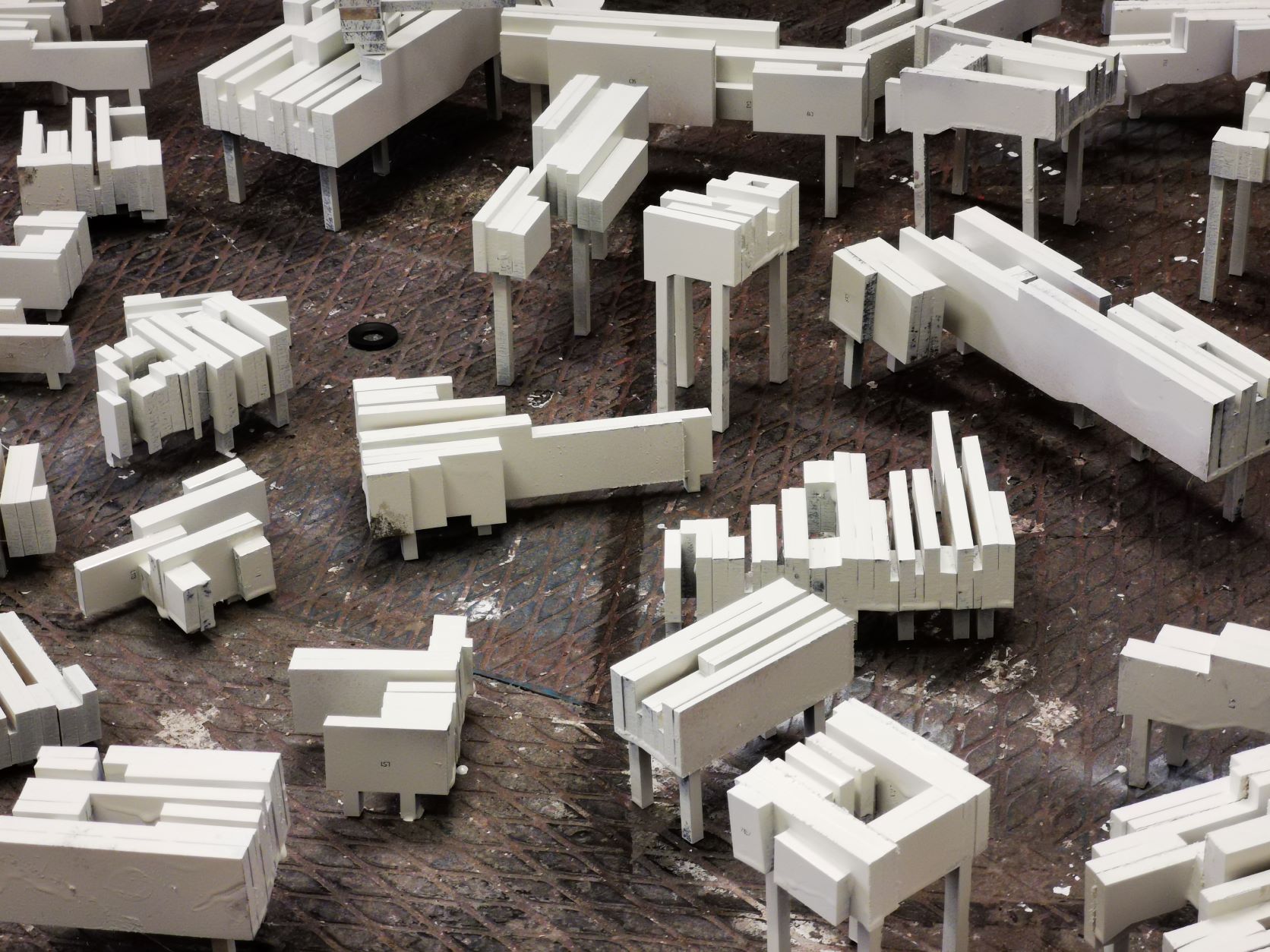
[Festival urbanism] - Ecological Urbanism
"Humans should stop their parasitic abuse of nature and instead establish a two-way nature contract with nature." 1
在城市尺度上,人类、城市、自然共同达成混合体的生态平衡,塑造成为城市的 Proximity Atmosphere (TLML) - The Festival of Edinburgh。这可以理解为一种 Ecological Urbanism。
生态学远不只是简单的捍卫自然。Guattari强调“生态问题”作为在新的历史背景下塑造人类生存的一种方式的作用。与只在思想上定义的概念不同,他强调subjectification的进程应该运行在真实的'material existence' 上 2。生态城市主义作为实践手段,我们将剧院和表演在TLML尺度上涌现为城市节日气氛。,它是对多种新旧方法、工具,技术的重新组合,共同构建新的 a New Apparatus and a New Order。在这个进程中使社会运作体系成为自然哲学的一部分,而不只是从自然中索取,这是自然契约的开始。
在Festivel architecture的urbanism章节中 3,Christine Macy 剖析了Fasnacht 这个巴塞尔最盛大的节日。巴塞尔的街道和广场、地标和纪念碑通过节日被赋予意义 4。这让我重新思考了爱丁堡8月份遍布城市的艺术节表演,特别是为 Edinburgh Military Tattoo 构建的在城堡上的巨型临时剧场 - Tattoo arena。这不仅仅是壮观的建筑实体对于城市的空间被占据,人们同样参与到了节日的世界中,他们来自城市中的各行各业。从策划,准备,到表演,他们建立,并且融入了这个伟大的节日。

[The New Caledonian Forest] - TLML
在TLML尺度中 **'proximity'**成为了爱丁堡主体间关系的接近性,城市对节日的表演和庆祝是 Edinburgh's Festival Urbanism。如同人类对于原始的自然的认识一样,城市不同的几乎已经相互遗忘的主体,重新被proximity构建的festival联系在一起。这种自然的平衡所形成的城市环境就是proximity atmosphere TLML。
这就意味着人们为了一个共同的意识、目标、归属感进行的活动。城市的各种不同的群体在一起策划、准备、制作、庆祝。人类将生态哲学在城市尺度上,形成自下而上的生态学社会体系。这也是对完全以全球化为主导的城市化进程的反抗。
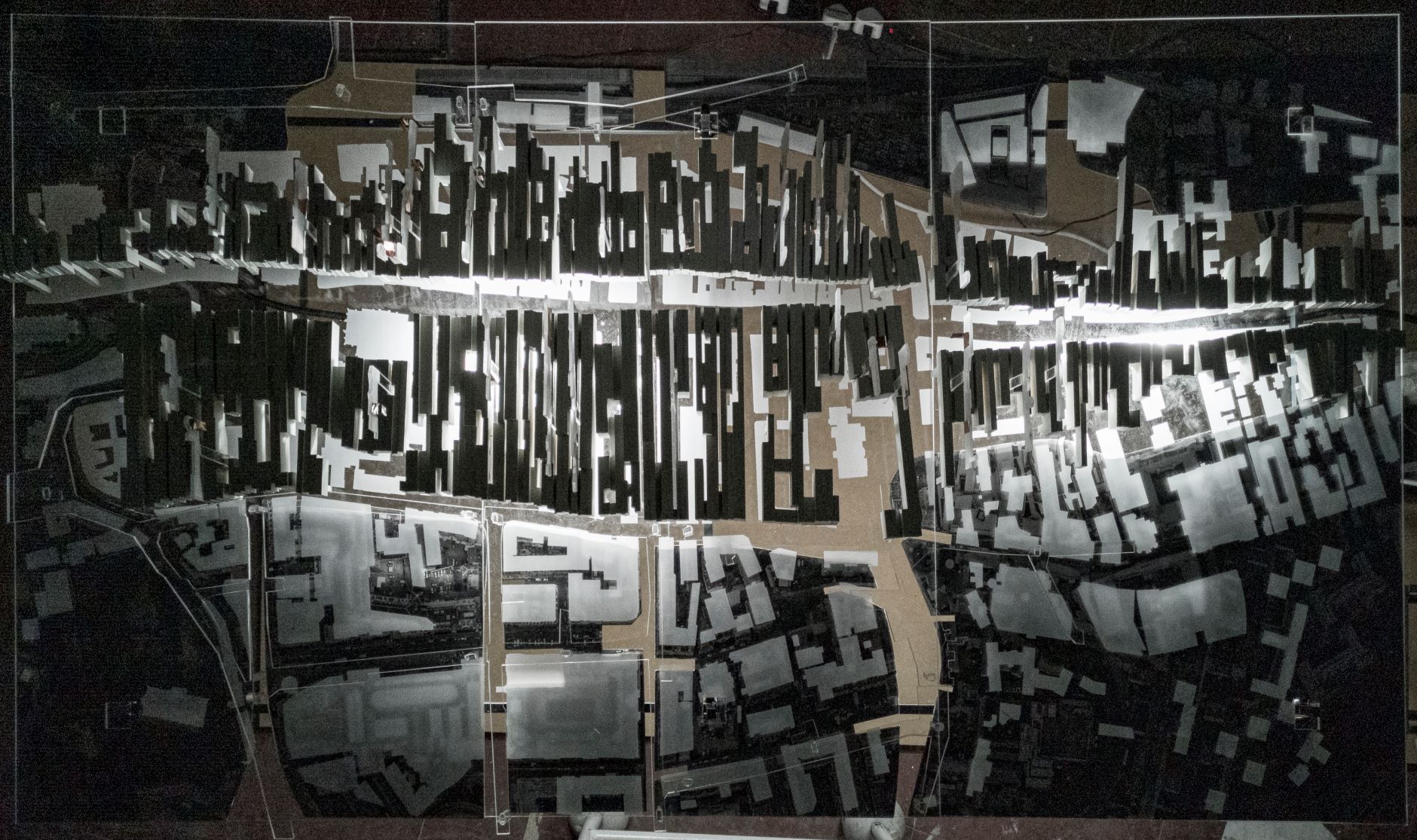
我们把Theatre在 Proximity Atmosphere中对老城的渗透过程,通过铜绿的形成和多层的图纸模型表达。对于Closes的历史、形成ProximityTheatre的Closes、老城街道中的节日气氛、Caledoian森林的生长,我们通过铜、灯的光影、透明亚克力、closes模型来隐喻。最后迭代多次形成多层的New Visualization。
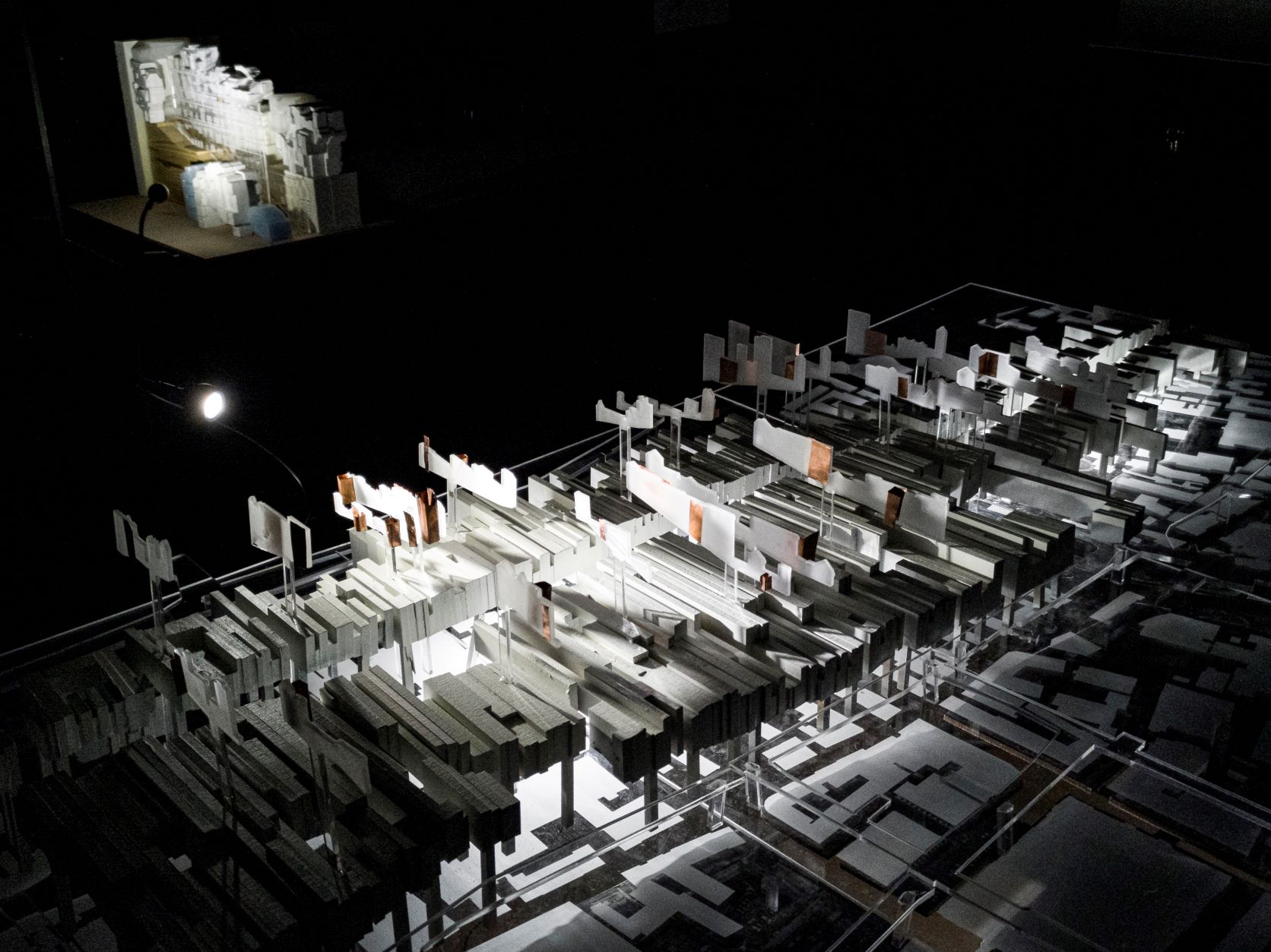
References
- Michel Serres, The Natural Contract (Ann Arbor, Mich.: University Of Michigan Press, 2011), 36–37.
- Félix Guattari, The Three Ecologies, trans. Ian Pindar and Paul Sutton (London: The Athlone Press, 2000), 69.
- Sarah Bonnemaison and Christine Macy, Festival Architecture (London ; New York: Routledge, 2008), 238–41.
- ibid.
[Proximity in Studio]
Chapter Ⅵ
Synecdoche, Edinburgh's Exhibition & Archive
Archive的客观性在Derrida的逻辑体系下,成为了一个完全的伪命题。媒介和技术绝不仅仅是被动的传达者,而是主动的档案构造者。媒介和技术的发展使得档案的意义和存在形式发生了很大的变化。
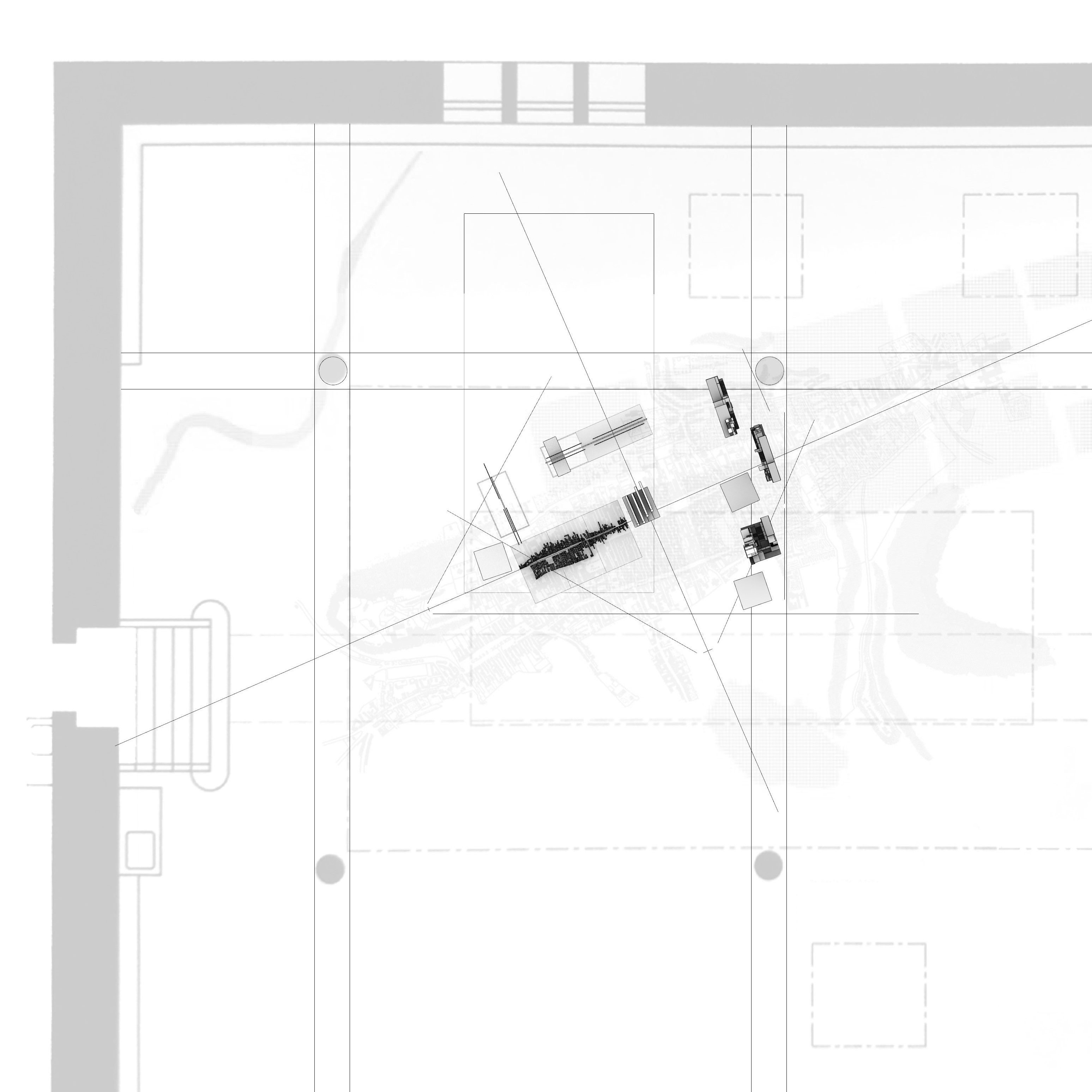
把古典archive和互联网时代下的Youtube类型视频平台相比,把佛洛依德提出的“Mystic Writing Pad”和Email相比。可以说archive的存在空间从几乎的私人空间转向了更多的公共空间。媒介和技术为构建者提供“apparatus”,又为archive提供内容结构。这个“中间体”的影响力越来越大。
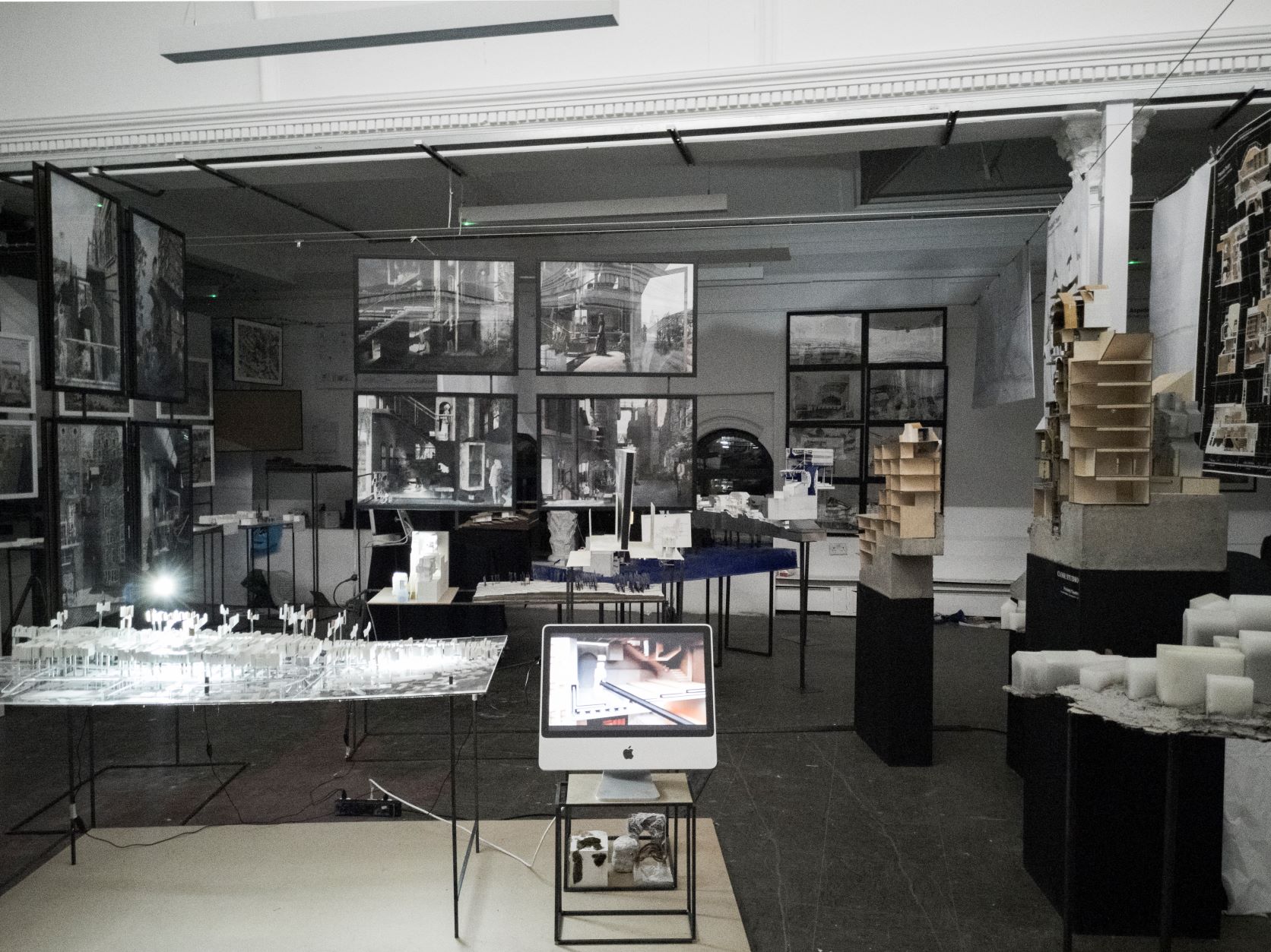
这也可以说我们在studio中的exhibition不仅是proximity theatre的一部分-synecdoche Edinburgh,还是构建archive的媒介和存放archive的空间arkheion。archive同时也是exhibition的角色,演绎proximity theatre,也是对synecdoche Edinburgh的再一次提喻。
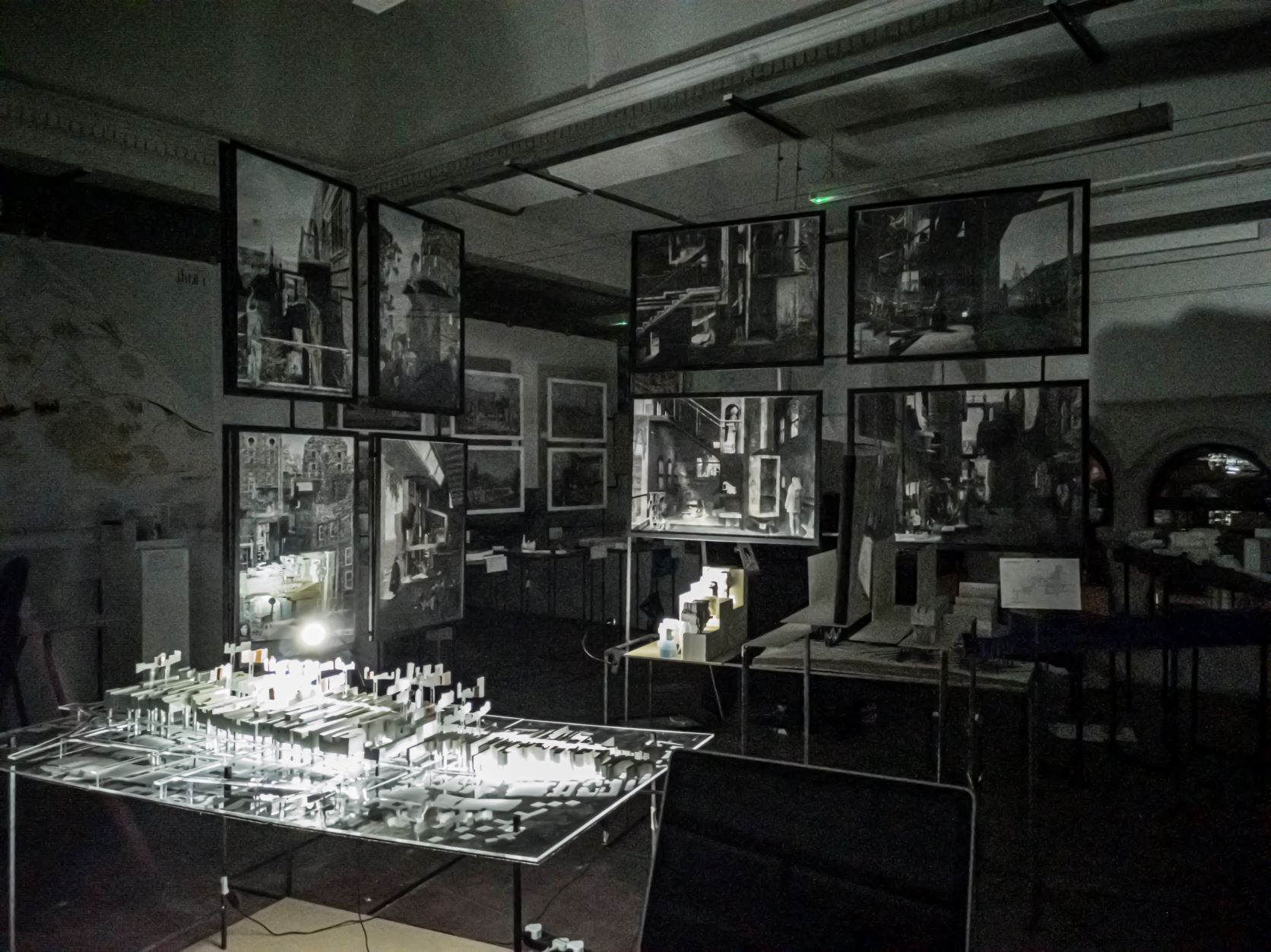
[CONCLUSION]
** The Caledonian Forest的理论让我们重新思考了人、森林、建筑之间的关系。通过剧本建筑空间(叙事性)和Copper Tectonic(材质和构件)进一步构建了剧院场景细节(DoA)。Synecdoche Edinburgh和Performative Urbanism引导我们构建城市空间和剧院空间以及剧院各部分设施构成完整亲密的生态学运行体系(NoA)。利用Absolute Urbanism的逻辑,将Theatre作为干预点,从单个岛屿发展为爱丁堡的 Archipelago。这些主体化的进程共同构成了Festival Urbanism,这也是爱丁堡的New Caledonian Forest(NV)。**
包括爱丁堡老城的发展过程,历史上城市的发展往往存在新城市区域的构建使得老城成为了所谓的平民窟,并且形成了恶性循环。批判的说,对于过去的继承和重建过去的生态似乎是矛盾的,Closes在平民窟时期的生活的混乱也是其重要的文化和历史。但从Geddes对于Closes的改造方式看得出他对于Closes的历史是尊重的。哪怕是对于受到批判的黑暗的历史时期。Guattari所反对的是极端的否定或是继承。资本主义的权力所形成的自上而下的“规划”,使得城市local文化很容易被忽视,让步与所谓的城市整体规划。Geddes所提出的 Think Local, Look Goable,Guattari的三种不同尺度的生态学,都是对于自下而上的发展在批判中继承的具体解读。
我们必须意识到存在于更大的城市和国家的各个领域之间的可见和不可见的社会关系。而这种动态关系的“Subjectification”并不能简单的通过物质实体实现,这是一个值得研究的问题。
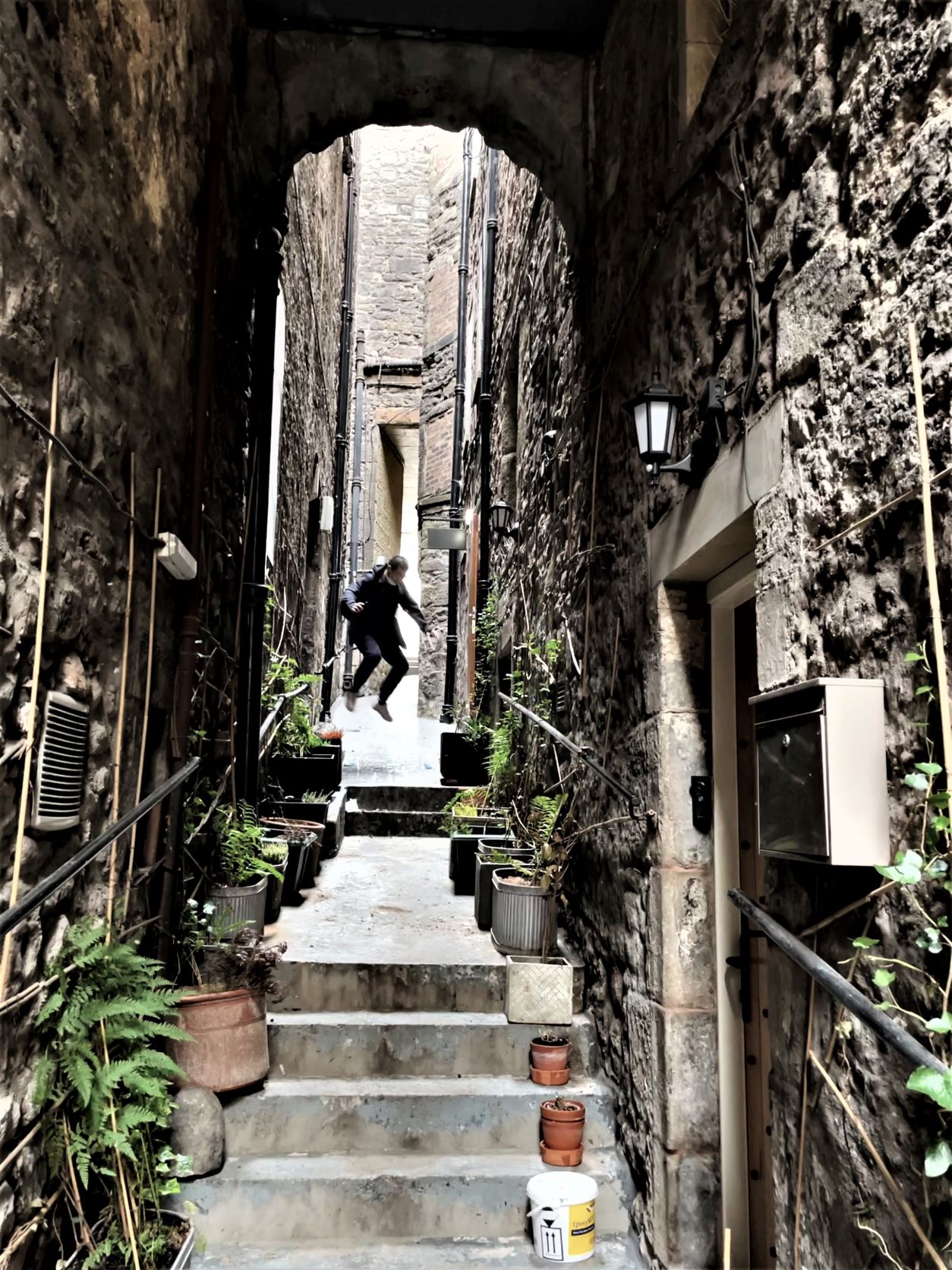
[Bibliography]
- Adorno, Theodor. Aesthetic Theory. Translated by Robert Hullot Kentor. Minnesota: University of Minnesota Press, 1998.
- Agamben, Giorgio. Potentialities : Collected Essays in Philosophy. Edited by Daniel Heller-Roazen. Stanford, Calif.: Stanford University Press, 1999.
———. What Is an Apparatus? : And Other Essays. Stanford: Stanford University Press, 2009. - Allen, Stanley, and G. B. Piranesi. “Piranesi’s ‘Campo Marzio’: An Experimental Design.” Assemblage, no. 10 (December 1989): 71–109. https://doi.org/10.2307/3171144.
- Bateson, Gregory. Steps to an Ecology of Mind. Chicago: University Of Chicago Press, 2000.
- Baudrillard, Jean. Simulacra and Simulation. Ann Arbor: The University of Michigan Press, 1994.
- Bonnemaison, Sarah, and Christine Macy. Festival Architecture. London ; New York: Routledge, 2008.
- Clément, Gilles. “‘Le Tiers Paysage’ (El Tercer Paisaje),” 2004, disponible en línea : http://www.gillesclement.com/.
- Derrida, Jacques. ARCHIVE FEVER : A Freudian Impression. S.L.: Univ of Chicago Press, 2017.
- Edgar, Willm. The Plan of the City and Castle of Edinburgh. 1742. National Library of Scotland.
- Eisenstein, Sergei M. Piranesi, or the Fluidity of Forms. Translated by Roberta Reeder, 1977.
- Emanuele Coccia, and Dylan J Montanari. The Life of Plants : A Metaphysics of Mixture. Cambridge, Uk ; Medford, Ma: Polity Press, 2019.
- Flusser, Vilém. Gesture. Minneapo lis: University of Minnesota Press, 2014.
- Freud, Sigmund, James Strachey, Anna Freud, Alix Strachey, and Alan Tyson. The Standard Edition of the Complete Psychological Works of Sigmund Freud. Vol. 19, the Ego and the Id ; and Other Works : (1923-1925). London: Vintage, 2001.
- Geddes, Patrick. Cities in Evolution. NEW AND REVISED EDITION. London: Williams & Norgate, 1949.
- Gilles Clément. Manifeste Du Tiers Paysage. Paris: Sujet - Objet, 2004.
- Gilles Clément, Maurici Pla, and Susana Landrove. Manifiesto Del Tercer Paisaje. Barcelona: Gustavo Gili, 2018.
- Guattari, Félix. The Three Ecologies. Translated by Ian Pindar and Paul Sutton. London: The Athlone Press, 2000.
- Home, Bruce. Drawing of Old Town. 1800. Civic Survey.
- Jean-François Bédard, Alan Balfour, Canadian Centre For Architecture, and Et Al. Cities of Artificial Excavation : The Work of DustPeter Eisenman, 1978-1988. S.L.: Rizzoli, 1994.
- Kirkwood, Robert. Fac Simile of Gordon of Rothiemay’s Bird’s-Eye View of Edinburgh. 1817.
- LACMA. The Treachery of Images (This Is Not a Pipe) (La Trahison Des Images [Ceci N’est Pas Une Pipe]). n.d.
- Lucchese, Daniela. “Performative Urbanism | Book Review.” Urban Design Group, March 24, 2020. https://www.udg.org.uk/publications/book/performative-urbanism.
- Luce Irigaray, and Michael Marder. Through Vegetal Being : Two Philosophical Perspectives. New York: Columbia University Press, Cop, 2016.
- Mairet, Philip. Pioneer of Sociology : The Life and Letters of Patrick Geddes. Westport, Ct.: Hyperion Press, 1979.
- Mostafavi, Mohsen. “Harvard Design Magazine: Why Ecological Urbanism? Why Now?” Harvarddesignmagazine.org, 2009. http://www.harvarddesignmagazine.org/issues/32/why-ecological-urbanism-why-now.
- Pier Vittorio Aureli. The Possibility of an Absolute Architecture. Cambridge: Mit Press, 2011.
- Scarpa, Carlo, and Francesco Dalco. Carlo Scarpa : The Complete Works. Milano: Electa, 1987.
- Serres, Michel. The Natural Contract. Ann Arbor, Mich.: University Of Michigan Press, 2011.
- Steedman, Carolyn, and Rutgers University Press. Dust : The Archive and Cultural History. Machester, Uk: Manchester University Press, 2001.
- Synecdoche, New York. United States: Sony Pictures Classics, 2008.
- Tanizaki, Jun’ichiro. In Praise of Shadows. S.L.: Vintage Classics, 2019.
- Tutt, Daniel. “What Is an Apparatus?” Daniel Tutt, July 20, 2011. https://danieltutt.com/2011/07/19/what-is-an-apparatus/.
- Wolfrum, Sophie, and Nikolai. Performative Urbanism : Generating and Designing Urban Space. Berlin: Jovis, 2015.